Updated 31st December 2017 It would appear that whilst members appreciate ice and snow on their Christmas cards when it comes to the real thing they're reluctant to leave their firesides for a bracing walk around the Northwich Woodlands! So it was only a small group of stalwarts [noun: a loyal, reliable, and hard-working supporter of or participant in an organization or team] who braved the elements for the Christmas walk (29/12). It was pretty bad though I must admit! Heavy rain overnight that changed into wet snow at around 9:00am with a temperature of only 1 ° C as we set off from the car park next to the Stanley Arms. The path alongside the River Weaver was a bit tricky; frozen compacted mud with a topping of melting snow - eyes down rather than scanning the landscape for birds. 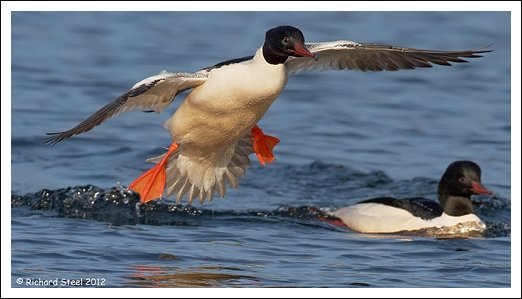 Teal, Cormorant, Mallard, Moorhen and a single Great Crested Grebe were all noted on the river before we took the steep steps up from the path to Haydn's Pool. The pool was pretty much deserted just a couple of Snipe and in the distance, surveying it's domain from the top of one of the old ICI chimneys, a lone Peregrine. Teal, Cormorant, Mallard, Moorhen and a single Great Crested Grebe were all noted on the river before we took the steep steps up from the path to Haydn's Pool. The pool was pretty much deserted just a couple of Snipe and in the distance, surveying it's domain from the top of one of the old ICI chimneys, a lone Peregrine.A bit more of interest in the woodland adjacent to Budworth Mere and on the mere itself where the highlight was a group of Goosanders - 2 fine males and 7 female/immature birds in a flotilla close to the mereside opposite the sailing school. The usual mix of woodland species - Jay, Treecreeper, Bullfinch, Nuthatch as we made our way to the viewing screen where Blue, Great and Coal Tits were feeding; both Great Tits and Coal Tits were in song during the morning. Up to six Hawfinches have been seen in the Old Hall area but once again we missed out although we did have a quick scan before making our way back to the cars; 3 hours in total which helped to blow the Christmas cobwebs away. Passerines seemed to be down in numbers this year, I'm guessing that many species are taking advantage of garden feeders. We have two, one of which was designed and built by a friend and features the usual wire mesh front but which additionally curves round underneath at the bottom. It's filled with sunflower hearts and is attracting large numbers of Green and Goldfinches, especially the latter with up to 20 at any one time. The seeds are also dislodged from the bottom mesh onto the ground where they're consumed by Blackbirds, Dunnocks, House Sparrows, Chaffinches and recently 4 Bramblings. There's a three week break now before our next KOS group activity beginning on the 20th January with the trip to Connah's Quay followed the next day by the Tatton Wildfowl Event in conjunction with the Tatton rangers. On the 26th it's the January indoor meeting with Jim Almond followed by the Great Garden Birdwatch on Knutsford Moor (27th) with the Friends of the Moor group and finally on the 28th we repeat the Garden Birdwatch with the Friends of Knutsford Heath.
19/12/2017...... A record breaking Christmas party! A busy weekend for KOS members with the annual Christmas party on Friday (15th) followed on Sunday (17th) by the trip up to Marshside and Martin Mere. The party went very well and, as our treasurer Frank Dearden reports in his email, we made a welcome profit during the evening. Greetings, Attendance £ 224.00 Raffle and bird lottery £ 67.00 Bring and buy/Auction £ 41.80 Total income £ 332.80 Expenses £ 36.40 Profit £ 296.40 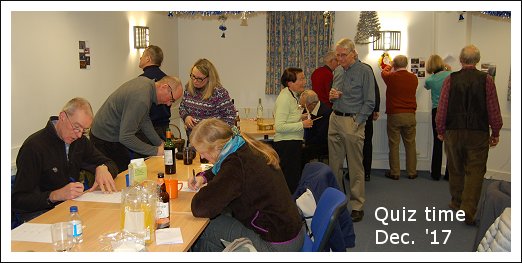 Twenty-four people were in attendance on the night but some who could
not be there sent in donations to compensate so the attendance money is
equivalent to twenty-eight persons.
Securing quality speakers for our small society is an expensive business
and we, quite reasonably, want to offer the best lectures we can to our
members. The average cost for a lecturer is currently
£
120 per visit so
the profit generated by yesterday's efforts buys us 2.5 speakers. That
is approaching half of a whole season's expenditure on lecturers and
reinforces how important the Christmas party is in generating funds to
keep the Society going in its current format.
To all those who contributed their time, effort or funds to staging last
night's event, and to those who came and opened their purses/wallets, a
great big thank you from the man who takes care of the cash.
Merry Christmas,
Frank
Thanks Frank, as efficient as ever, we were all glad to see you back in circulation and in such good form! Twenty-four people were in attendance on the night but some who could
not be there sent in donations to compensate so the attendance money is
equivalent to twenty-eight persons.
Securing quality speakers for our small society is an expensive business
and we, quite reasonably, want to offer the best lectures we can to our
members. The average cost for a lecturer is currently
£
120 per visit so
the profit generated by yesterday's efforts buys us 2.5 speakers. That
is approaching half of a whole season's expenditure on lecturers and
reinforces how important the Christmas party is in generating funds to
keep the Society going in its current format.
To all those who contributed their time, effort or funds to staging last
night's event, and to those who came and opened their purses/wallets, a
great big thank you from the man who takes care of the cash.
Merry Christmas,
Frank
Thanks Frank, as efficient as ever, we were all glad to see you back in circulation and in such good form!
On Sunday Marshside lived up to it's reputation as being one of the coldest places on earth! Dry as we left Knutsford but when we reached our destination it was raining heavily and the temperature was reluctant to rise above only 3
°
C. so it was off immediately to the shelter of the Sandgrounder's hide. It wasn't much warmer in there but at least it was dry. Given the time of year there weren't many people at Martin Mere although a few brave kids seemed to have persuaded their parents to "Sail to Santa" across the water in front of the reception building where we ate our lunch before moving to the restaurant for a coffee. The highlight of the afternoon came as we sat in the Ron Barker hide and watched five Marsh Harriers quartering the reedbeds. Apparently, earlier in the day, there were seven in view at the same time! There was the usual scrum at feeding time with 1,600 Whooper Swans and a sea of Shelducks hoovering up the grain but we saw only a couple of Ruff this time despite a count of 83 during the morning. A reminder that this year's Christmas walk will take place on Friday 29th December meeting up at the public car park next to the Stanley Arms in Anderton at 09:45am. Derek has a 4.3 mile walk planned which, with stops, should take us about three hours.
Our latest indoor meeting on 24th November went off very well when 35 Members and guests enjoyed an entertaining presentation by Danny Green entitled "The Land of Ice and Fire". Danny's images obtained during extreme winter conditions in some of the most inhospitable places on our planet were exceptional and it's no wonder he's built up a reputation of being one of the country's top wildlife photographers. Evenings in the company of such exceptional 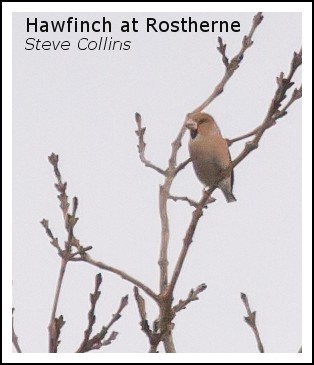 talent don't come cheap though and so this is perhaps a good time to remind members that one of our most important sources of income is the annual Christmas party which takes place this year a week on Friday (15th December) in the Jubilee Hall - members will have all received an email from Derek with the appropriate details. Please also note that the trip to Marshside and Martin Mere has been moved from the 10th of December to Sunday the 17th, meeting in the Tatton Street car park at 9:00am. talent don't come cheap though and so this is perhaps a good time to remind members that one of our most important sources of income is the annual Christmas party which takes place this year a week on Friday (15th December) in the Jubilee Hall - members will have all received an email from Derek with the appropriate details. Please also note that the trip to Marshside and Martin Mere has been moved from the 10th of December to Sunday the 17th, meeting in the Tatton Street car park at 9:00am. Despite the early onset of Winter one or two members have been out and about - Bob Groom was in Tatton last Wednesday (30/11) and mentions the absence this year of Goldeneye... 2 Kingfishers, flying low over Tatton Mere. Not a lot of wildfowl on Tatton, a few Tufted etc. but where are all the Goldeneye? Melchett Mere, however, was much livelier - 4 Pintail (2 m), 5 Pochard, 14 Wigeon, 5 Cormorants, 5 Tufted, 4 Great Crested Grebes, 21 Mallard, 16 Coot, 2 Teal, 1 Moorhen, 1 Greylag , 400+ Canada Geese, also around, a small party of Siskins, Great Spotted Woodpecker, Mistle Thrush, Nuthatch.. I found just a couple the following day (30th) at the south end of Tatton Mere, seven Mandarins sheltered in the shallow water amongst the tree roots of the Higmere plantation. Knutsford Moor was partially covered by ice on which a large flock of Black-headed Gulls were resting; two were ringed both with metal rings on their right legs and long blue rings with white lettering on their left - too far away to make out any lettering. Ranger Darren Morris tells me that a Stonechat has been seen regularly in Tatton's deer enclosure, he also kindly sent a copy of the Tatton Wildlife Newsletter for Winter 2018 - 18 [click here] that event on the 21st January looks good Darren!
I've not had any luck yet with the Hawfinches, although they're still widespread in our area. Two have been seen recently at Marbury and Brian and Alison Dyke had two again at Rostherne, plus a Lesser Spotted Woodpecker! Having heard that Hawfinches had been seen at Rostherne again at the weekend (and as Alison hadn't caught up with any yet) we went there this morning to have a look for them. After about an hour, one flew over and disappeared behind trees next to the cricket pitch. Alison managed to find this one, at the top of a tree in the garden of Rostherne House (the house next to the car park) just as I spotted another flying around over the cricket pitch before joining the first one. They only stayed for a couple of minutes before flying off and we lost them. To make the morning even better, we also had a fairly brief view of a male Lesser Spotted Woodpecker in the birch trees right of the observatory before it flew left and out of sight. We couldn't relocate it! Bob Groom and I were at Rostherne last Wednesday (15th) Bob had one flying in the distance but I never got onto it, the reserve was very quiet, no sign of the four Whooper Swans Bob discovered on the 9th although we did have an over wintering Chiffchaff in one of the reedbeds; Steve Collins tells me a Bittern was seen on the reserve last Sunday (19th). I spent three hours yesterday morning (Tuesday 21st) in Tatton, beginning on Knutsford Moor and walking at a very leisurely pace through Dog Wood as far as the old bathing area. There were very few birds on the Moor pools just a few Canada Geese, Coot and Tufted Ducks On Friday (24th) we welcome the award winning Natural History photographer Danny Green to the Jubilee Hall where he will be giving an audio visual presentation entitled "Land of Ice and Fire". Judging from his website this promises to be something rather special - click here - non-members are welcome at any of our meetings.
A trouble-free journey of 75' from Lilac Avenue to Llanfairfechan on Saturday (11th) for our November field trip to North Wales. The weather behaved itself - dry with some periods of sunshine but mostly overcast with a maximum temperature of only 9 ° C in mid-afternoon. We enjoyed the company of Ken and Shirley Davies making a welcome cameo appearance in-between their European camper van adventures, so despite the absence of some regulars we managed a full team of 11 just in time for kick-off as we set off along the promenade towards the Morfa Madryn reserve about a mile to the west. The tide was out but using the 'scopes we picked out Great Crested Grebes and small flocks of Common Scoters bobbing about on the sea whilst closer to us Redshank, Dunlin, Curlew, Black-tailed Godwits and large flocks of Oystercatchers were feeding on the intertidal mud flats.  The small stream that runs out into the sea close to the car park is apparently called Afon Llanfairfechan, we always pause there as "it looks a good place for Dipper" but we've never been lucky. However, being made of sterner stuff, Simon and Lyn ventured a little further up the riverside and found one! also there a Grey Wagtail that moved down towards the bridge and put on a nice show as we watched. The small stream that runs out into the sea close to the car park is apparently called Afon Llanfairfechan, we always pause there as "it looks a good place for Dipper" but we've never been lucky. However, being made of sterner stuff, Simon and Lyn ventured a little further up the riverside and found one! also there a Grey Wagtail that moved down towards the bridge and put on a nice show as we watched.House Sparrow, Chaffinch and Mistle Thrush were added to the day list as we passed the allotments but the big mixed wood that's normally quite productive was very quiet on this occasion so we move quickly on to the Glan y mor Elias salt marsh where a huge flock of Wigeon were grazing. There must have been at least 500 - from a distance they looked like hailstones lying on a lawn after a hail storm! Also in that area, Meadow Pipits, Linnets, Lapwings, Teal, Skylarks and a single Little Egret. As we've found before the best of Morfa Madryn's hides is the third one along, overlooking a large stretch of fresh water this held Shelduck, 3 Little Grebes, 5 Snipe and 6 very vocal Greenshanks, these alone making the trek from Llanfairfechan well worth the effort - great birds. A few more species were added on the return walk to our starting point, Long-tailed and Blue Tits, 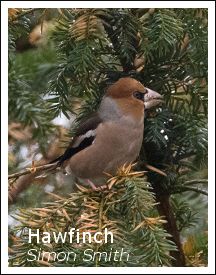 Dunnock and a group of Turnstones on the rocks that were shortly to be covered by the incoming tide. Dunnock and a group of Turnstones on the rocks that were shortly to be covered by the incoming tide.A short drive of 10' found us at the RSPB's Conwy reserve where we availed ourselves of the facilities in the cafe before moving onto the hides. We only added a few species to the list - the reserve was unusually quiet and the light was beginning to fade but Coot, Coal Tit, Shoveler, a singing Cetti's Warbler and five Red-breasted Mergansers (1 male plus 4 female/immatures) were all noted bringing the final total to a creditable 58 species. Simon and Lyn were considering a trip over to Rostherne for the Hawfinches but in the event they didn't have to bother as one conveniently appeared in their garden, posing nicely in a conifer tree! They went instead on Monday (6th) to Connah's Quay for the high tide and report that up to 70 Twite have returned for the Winter so that's encouraging news for KOS members as we have a trip there in January. Bob Groom also drove to the coast on the same day, in his case to Parkgate over the other side of the Dee estuary where he saw some good birds - The weather was good this morning so I headed for the high tide birdwatch at Parkgate. The M6 was at a standstill so I used the A559 to get to M56. With no wind behind it the tide didn't come in very far but there were still lots of good birds to be seen, including 6 species of raptor. Marsh Harriers were around all the time (max 4 females), a Merlin was chasing the small birds, there were no less than 3 Peregrines, and I managed to put a group on to the male and female Hen Harriers. 3 Great Whites, Pinkfeet, Stonechats, Linnets etc. but no owls. Lovely sunshine and not that cold.
Over the past few years we've become accustomed to welcoming large flocks of Waxwings to our area in the late Winter. They don't show up annually, often there are gaps of many years - sometimes decades between their appearance 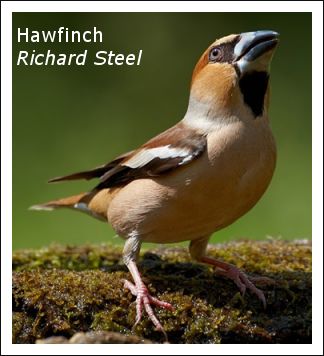 as they desert their normal wintering areas due to shortage of food or adverse weather conditions and head in our direction. These sporadic incursions are referred to as irruptions and occur with other species, this year an irruption of Hawfinches has taken place with reports from all over the country involving many thousands of birds. as they desert their normal wintering areas due to shortage of food or adverse weather conditions and head in our direction. These sporadic incursions are referred to as irruptions and occur with other species, this year an irruption of Hawfinches has taken place with reports from all over the country involving many thousands of birds. The first report from Cheshire came on Thursday (2nd) when Steve Collins' early warning system informed us that Sheelagh Halsey had seen a Hawfinch at Rostherne Mere in mid-afternoon, Bob Groom then had no less than six birds the following day in trees adjoining the cricket pitch just off the reserve. Bob and I returned to try and re-locate them on Saturday morning (4th), unfortunately we only had a limited amount of time and had no luck - but they were actually still there as, later in the day, Brian Dyke sent me an email with news of four birds he'd seen just after we'd left. Bob and I spent a short time in the observatory before leaving for home and had excellent views of a Peregrine coasting back and to just over the surface of the mere chased by a noisy flock of gulls, eventually it grew tired of them, stepped up a gear and left them trailing in it's wake as it headed off in the direction of Tatton Park. We counted seven Goldeneye on the mere, over at Tatton Darren Morris had a male and female of this species on the 27th October - possibly the first of the Winter. Four days later on the 31st Bob noted small flocks of Shoveler and Pochard on Tatton and Melchett meres, he also had a large flock of 70+ Linnets on the big field leading to the outdoor centre. This coming Saturday (11th) we have our November field trip to North Wales including Llanfairfechan, Morfa Madryn and Conwy RSPB. We leave Lilac Avenue at 09:00am so should arrive in Llanfairfechan at about 10:15am. Yesterday at Conwy they had a Great White Egret and a Firecrest. I rang our Treasurer Frank Dearden today and I'm pleased to report that he's recovering well from his recent operation, he's able to walk a couple of kilometers at normal pace and the re-arranged plumbing is working well! 20/10/2017...... The first of our Winter visitors We recorded Redwings (and Fieldfares) on our recent trip up to Lindisfarne, they've now moved down as far as Cheshire, Darren Morris reports Redwings in Tatton from 9/10 and I had a flock of 17 the next day in Mobberley. Redwings migrate at night and you can hear their high pitched calls as they pass over if you stand outside on a clear October evening. Also in Tatton Derek Pike noted that one of the over-wintering Stonechats has re-appeared close to the Allen hide and Darren had a flock of c. 200 Pink-footed Geese flying north-west over the park on the evening of 17/10. Tropical storm Ophelia came and went causing big problems in Ireland both north and south; here we had some very strong winds on Monday (16th) when the wind speed as From the Naturetrek website - "Tim has had a keen interest in all forms of natural history since childhood. A testament to his knowledge is that he was overall runner-up in the first series of the Radio 4 natural history quiz 'Wild brain'. His main interest is birds, although he has considerable expertise in mammals, butterflies, moths, dragonflies and wild flowers. He has worked in nature conservation all his life and has been conservation officer for the RSPB since 1988. He has a degree in Zoology and a PhD in butterfly ecology. He gives numerous talks on various wildlife topics all over the north of England and became secretary to the BOURC (British Ornithologists' Union Records Committee) for a 10-year period in 1998. He currently lives on the edge of the Peak District with his wife and three children."............ so this is one not to be missed! Barry Jordan is back home after his adventures in Cyprus teaching Johnny Foreigner how to behave. Bird report - CABS and Birdlife Cyprus 5 weeks on #Cyprus: 1,630 lime sticks+80 nets collected. 71 electronic decoys dismantled, 16 poachers caught+(best number) 181 birds freed. British Military Police on SBAs did even better and local magistrates doling out hefty fines and prison sentences (suspended and immediate). Well done Barry. I believe with your new-found skills you'll be moving on to help with Brexit negotiations!!
I've received emails from three KOS members updating us on their current, widely varying activities and they're reproduced below for your delectation. Barrie Armitt has been off again on one of his solo trips; this time to Scandinavia. It's the shortest point between Sweden and Denmark and the birds are funnelled to the peninsula before reaching water and deciding if they fancy the crossing - about 16kms. The migrants fly to the point where the birders/counters sit/stand, check out the conditions and either keep going or turn back. On the best days 160,000 Chaffinch/Brambling- amongst other mind-boggling numbers will pass in the counting period from half an hour before first light until 2pm: but not this week! Still, I wasn't at all disappointed. Lots of birds to be seen in numbers and variety. For example 756 Sparrowhawks last Thursday was awe inspiring enough for me though much lower than the big numbers they record here. A good mix of raptors providing good views ( biggest daily count in brackets ) - White-tailed Eagle (5), Honey Buzzard (18), Common Buzzard (530), Marsh Harrier (51), Red Kite (619),Rough-legged Buzzard (10),Lesser Spotted Eagle (1), Osprey (2), Kestrel (28), Hobby (5),Merlin (6). The day we arrived they had 58,500 Chafflings (Chaffinch/Brambling) mixed flocks but we missed the morning session unfortunately. I'm filled with excitement when I see a single Swallow go past with that evident fixed intent of the migrant that there was more than enough to marvel at in a 'quiet' week at Falsterbo! Our other Barry - Barry Jordan is again in Cyprus on anti-poacher patrol. Out with 6 Police, 2 Rangers and a dozen conservation volunteers to catch some of the worst bird trapping offenders at Paralimni..... caught them red handed....3 of them tried to make a run for it but were cornered..... fight ensued...... I got a fist in my face, a fat lip and a kick in the crotch for good measure. I'm not very good at street fighting LOL .....Good news is that they will get stiff fines and even prison for resisting arrest, and especially for assaulting police officers on duty in full uniform. The magistrates often don't give out much punishment for bird law breaking, but assaulting the Police is another matter entirely. Barry.... suffering a bit this morning, but feeling good for doing my bit. Well done Barry you are now qualified to man the doors at this year's KOS Christmas party! Hugh Pulsford and the ringing team have been out again on Knutsford Moor - a bit safer than Cyprus! Hi Tony............I thought the folks would enjoy the attached.
04/10/2017...... KOS long weekend in the North-east This is a relatively long report on the long weekend away in the north-east so I've put it on a page of it's own. CLICK HERE 21/09/2017...... Lucky escape for Knutsford birder! Bob Groom has been doing his monthly WeBS wildfowl count at Tabley for around 40 years now but on Sunday (17th) decided sensibly that discretion really is the better part of valour! It was supposed to be my Tabley count day, but I turned back as the narrow paths were treacherous with mud and water. the first time I've ever had to abort a count. So I drove to Holford in a downpour and parked by the Keeper's 'Cottage'. Saw a Sparrowhawk, but little else so I thought I'm half-way to Northwich Flashes and there are good paths so what the heck. The sun came out and I went down to Pod's Hide, I was joined by a guy called Dave Bedford, an expert birder who lives locally. We were really fortunate, a Golden Plover with the Lapwings and Curlews, then a Greenshank flew in and a Hobby came over, at one point buzzed by a female Sparrowhawk that had been around for some time but not caught anything. 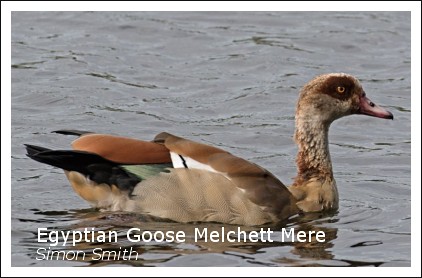 Also Buzzards, Little Egret, good views of a Reed Warbler and we heard a Water Rail, plus 3 Little Grebes and a good mix of ducks. A few heavy showers then I had Kestrel and Raven over Ashton's Flash and the sun shone, which is when I made my mistake. I decided to carry on to Haydn Pool but there were no waders there, just Kestrel and a distant view of Peregrine, making it a five-raptor day! I started back, heading for the layby where I'd parked but then the thunderstorm arrived, flooding the paths and literally soaking me to the skin, not to mention the hailstones. Thunder rolled and lightning flashed overhead. When I got near to my car there was a tremendous crack and a smell like cordite, lightning had obviously struck something close by but I bundled myself into the car and headed home, with a double rainbow in the sky ahead. Well done Bob - you can't keep a good man down! Also Buzzards, Little Egret, good views of a Reed Warbler and we heard a Water Rail, plus 3 Little Grebes and a good mix of ducks. A few heavy showers then I had Kestrel and Raven over Ashton's Flash and the sun shone, which is when I made my mistake. I decided to carry on to Haydn Pool but there were no waders there, just Kestrel and a distant view of Peregrine, making it a five-raptor day! I started back, heading for the layby where I'd parked but then the thunderstorm arrived, flooding the paths and literally soaking me to the skin, not to mention the hailstones. Thunder rolled and lightning flashed overhead. When I got near to my car there was a tremendous crack and a smell like cordite, lightning had obviously struck something close by but I bundled myself into the car and headed home, with a double rainbow in the sky ahead. Well done Bob - you can't keep a good man down!Much more benign conditions for us on Wednesday (20th) for a long overdue visit to Tatton park. Starting from the Dog Lodge layby we made our way through Knutsford Moor and alongside the main mere to the Allen hide before returning via Dog wood. As we've found over the years in the week preceding our first KOS indoor meeting of the season a Chiffchaff was singing on the Moor, it's song mingling with the wistful Autumn renditions of the local Robins. A good selection of waterfowl on the Moor's back pool including Mallard, Canada Goose, Coot, Moorhen, Gadwall, Dabchick and a graceful female Pintail, perhaps one of the birds we saw on Tatton earlier in the year. 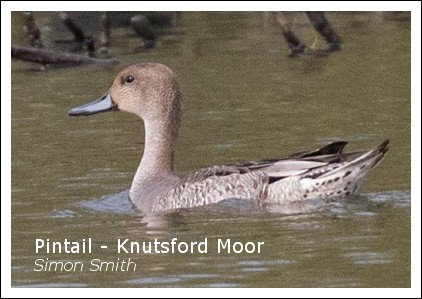 Very quiet on Tatton's main mere just a few Great Crested Grebes and a scattering of wildfowl at the south end - difficult viewing though at that time of the morning with the sun in our faces; a single Swallow passed through heading steadily south. More of the same on Melchett Mere, as viewed from the Allen Hide, although two Pochard were additions to the list as were three Egyptian Geese, a pair bred in the park earlier this year. Three raptor species on the return leg as we surveyed the view across the horse paddocks and on over the Cheshire plain toward Alderley Edge and the Pennines from close to the outdoor centre - Buzzard, Kestrel and Sparrowhawk. A nice wide ride has been created in Dog Wood allowing easy access to the waters edge, it was made to allow heavy machinery access during construction of a replacement deer fence across the mere, a Kingfisher gave good views as it perched on one of the new fence posts and a party of eight Little Grebes passed easily through the new steel mesh. That was our last record although Roger Barnes, who had left us earlier to do a circuit of Melchett recorded Green Woodpecker - species number 43. Don't forget on Friday (22nd) it's our first indoor meeting of the new season at the Jubilee Hall when Brian Anderson will be giving us a presentation entitled "Feathers and Wings". It sounds good!
A challenging journey to Hilbre on Saturday morning (9/9) with heavy rain and spray as we made our way carefully along the M56 and there was some discussion as to a plan "B" if 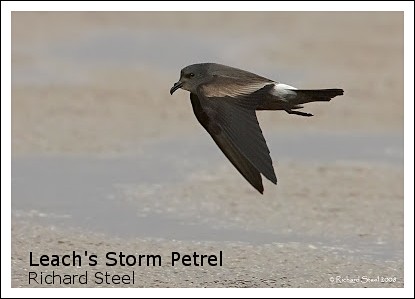 things hadn't become any better when we arrived at West Kirby. In the event things had improved, although the wind seemed even stronger and was directly into our faces as we made our way across the estuary towards Hilbre via the Little and Middle Eyes - hard going! A sudden squall as we reached dry land caught me out in the open and a small river of rainwater found its way into my pocket and rendered my trusty dictaphone useless hence this report and the list is being compiled from memory. things hadn't become any better when we arrived at West Kirby. In the event things had improved, although the wind seemed even stronger and was directly into our faces as we made our way across the estuary towards Hilbre via the Little and Middle Eyes - hard going! A sudden squall as we reached dry land caught me out in the open and a small river of rainwater found its way into my pocket and rendered my trusty dictaphone useless hence this report and the list is being compiled from memory.We ensconced ourselves in the usual spot with views over towards Red Rocks and Meols where we could see substantial flocks of waders wheeling around but after a time it became apparent that the majority weren't inclined to head in our direction on this particular occasion. So, compared with previous years, waders proved to be disappointing, we had plenty of Oystercatchers on the walk across plus a few Curlews and a couple of Turnstones but the expected arrival of Dunlins and Ringed Plovers in number just didn't happen. With such a strong wind coming in from the west we were cautiously optimistic that some of the more pelagic species would be blown in and they duly obliged. First a Manx Shearwater arrived and performed very well for us just off the lifeboat slipway - good views, and of course no windy day on the Dee would be complete without Leach's Petrels, reports of this species were widespread from the peninsula and along the Welsh coast, we saw two just offshore, making light of the gale force winds. Passerines were few and far between, we had a Wheatear on the island and on the way back two Meadow Pipits and two Linnets on the Middle Eye, no hirundines this time, normally under less arduous conditions we would have expected to see Swallows passing through at this time of the year. As we waited for the tide to recede a group of Welsh birders with whom we'd shared the island were 'scoping a wader in the distance on the Middle Eye amongst the Oystercatchers and a scattering of Curlews. It was resting on one leg and never actually took it's head and bill from it's back to give us a better view, I thought it may have been a Greenshank, it was relatively large with long legs and looked quite an elegant bird. So it remained unidentified but intriguingly last night (Sun 10th) Sheila Blamire emailed us to say that a Greater Yellowlegs had appeared on Hilbre Island during the morning - this may have been our bird!! I attach a couple of photos taken of some more interesting captures recently on the Moor. Snipe usually avoid mist nets but this one hadn't read the manual. This is an adult female, sexable on bill length, although there is an overlap this one was outside the range for a male. I would normally associate Snipe as a late autumn/winter visitor to the area, so the possibility that this had bred locally should not be ruled out. Grasshopper Warbler is not a species usually recorded here, and they are rarely seen in autumn anyway, so this was a nice catch. It is a juvenile, and was already building up its fat reserves ahead of it's long haul to south west Africa..... Hugh. Thanks Hugh your emails and images are always interesting and much appreciated by the troops!
Our local Swallows in Mobberley should be with us for another four weeks or so but they are becoming more animated and are already beginning to gather on the overhead wires in large numbers whilst others, in groups of three or four, can now be seen in mid-afternoon heading south in a purposeful manner. Mistle Thrushes form quite substantial group at this time of the year as family parties amalgamate, a flock of c.40 birds this morning was probably the largest I've ever seen. Last Thursday (31/8) was quite exceptional with further views of the long-staying Hobby and a rare sighting of a possible Honey Buzzard over Knutsford Moor. "I too had three Ravens, two adults and a bird or the year over us as we were ringing at Knutsford Moor. The juv Hobby too came through chasing House Martins without success normally mum or dad show them how, but this one was too noisy and not skilled enough. Grey Wagtails have started to move through, caught 4 today. Blackcaps are building up, and still Chiffchaffs and Willow Warblers about. Probably best bird got away, a Honey Buzzard went south over the town at 0730, but straight through so by the time the team realised what had overflown them , it had gone! I had back end distance views so couldn't confirm." Derek has dug out a copy of the 1975 KOS bird report, you can read it here - published in the days before spell checkers! This Saturday (9th) we travel over to the Wirral peninsula for our annual pilgrimage across the sands of Dee to Hilbre Island. Meeting in Lilac Avenue at 08:30 or 09:30 at West Kirby - Leader Tony Ellis............ Boyd knew it well.
Perhaps the final Swift of the year last Friday (25th) when Bob Groom had a single bird flying with c. 150 hirundines over Tabley Mere; on the same morning Darren Morris was lucky enough to watch a Hobby catching dragonflies 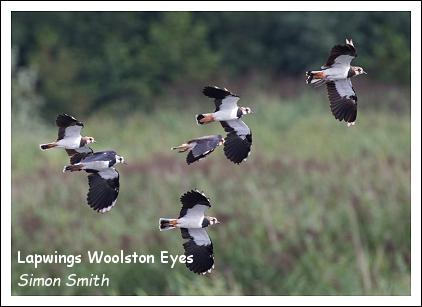 over the lagoon at the north end of Tatton Mere, it may linger in the area for some time, they normally stay with us until the end of September. over the lagoon at the north end of Tatton Mere, it may linger in the area for some time, they normally stay with us until the end of September.Last Tuesday (22nd) found us at Woolston Eyes again where we met up with Ken Davies who's returned from Scandinavia for a short time, seemingly to decorate the new kitchen, before setting off again with Shirley, this time to a wine festival in Germany before heading south the Croatia! The water level on the reserve has been lowered to attract passing waders and we recorded seven Black-tailed Godwits, a single Green Sandpiper and a small flock of c. 20 Lapwings. On the water an immature Black-necked Grebe showed intermittently whilst overhead a steady stream of southbound hirundines and the occasional Swift passed through. The dense areas of bushes and small trees were well populated with small passerines, we saw Greenfinch, Chiffchaff, Blackcap, Goldcrest, Common Whitethroat, Chaffinch, Blackbird plus Long-tailed, Blue, Great and Willow Tits. The CAWOS Facebook page tells us that 54 Blackcaps were ringed on the 26th August! I was talking about ringing to Lyn Graves as we made our way around the reserve on Tuesday, She's from the USA and it was interesting to compare the inclusive, open-house approach of bird banders in her home state of Colorado and, dare I say, the seemingly secretive and rather elite world of British ringers. [NB] I remember an open day some years ago at Woolston but I don't think there's been one this year. Eric Hardy often reviewed publications sent to him and gave his verdict during his Countryside programme on Radio Merseyside. Early in 1977 I sent him a copy of our own Knutsford Ornithological Society Bird Report for 1976, and he was quite complimentary about it. This tended to be the case, he was scathing about any professional publications that weren't up to scratch, but with amateur efforts he was much more relaxed and I never recall him causing embarrassment to any local bird report editors! He mentioned the comprehensive list of first and last records we were able to publish - first Spring records are easy enough but for the last records we relied on data passed on to us by the South Manchester Ringing Group comprising at that time of Malcolm Calvert, Stuart Burnet, Geoff Arrowsmith and John Shakeshaft (perhaps others too who's names I can't remember). I was reminded of this when Hugh Pulsford kindly sent the picture above of two Tree Pipits he trapped and ringed on Knutsford Moor recently, he caught five in four days. Without evidence like this the early autumn passage of passerines through our area would go largely un-noticed. There are still a few Swifts passing through, but in decreasing numbers, Bob Groom reported 6 on 15/8 over Queensway, 2 over Green Lane on 19/8 whilst Darren Morris saw a single bird this morning (21/8) over Tatton where he also reports a Wheatear passing through at the same time. As usual Bob's been very active, with two Hobbies, one at Anderton and a second in Plumley where he also had a Spotted Flycatcher. On his local patch along Moss Lane he recorded a large mixed flock of c. 500 Rooks and Jackdaws plus four Chiffchaffs fattening themselves up on an abundant supply of elderberries prior to their departure for warmer climes. We don't often get Hoopoes in this part of the world so I was pleased to receive a report from David Webb of a bird he saw perched by the roadside as he drove along the Alderley bypass, he sensibly chose not to stop due to heavy traffic at the time - I think one or two KOS members would have taken a chance! 11/08/2017......Holiday news! Hugh Pulsford has kindly sent us news of a well-travelled Blue Tit from Tatton Park that must have fancied a change of scenery ......An interesting recovery from a ringing attempt at Higmere plantation at Tatton. We had been trying to see if any Redwing were using the rhododendrons as a winter roost over both winter 2015 and subsequently. Unfortunately very few redwing seem to use that area any more but in a couple of attempts we caught a few of the local birds including a juv Blue Tit. Ringed on 15 December 2015 it was found nesting at Gibraltar Point in Lincolnshire this May 2017. This is the longest movement of this species South Manchester Ringing Group have ever recorded in it 50 year history. (182 k east) No obvious explanation for such a dispersal from the leafy lanes of rural Cheshire to the wind-swept, buckthorn covered sand dunes of Lincolnshire. Maybe even Blue Tits feel the need for an east coast holiday! Also on their holidays - Ken and Shirley Davies who, quite sensibly, again headed north to Scandinavia this Spring - Hi Tony I know this is a long time coming but computer problems got in the way .We had a interesting trip with no problems and the weather was not all that bad. Starting out on the 4th of May Travelling through Holland into Germany up into Denmark across by ferry to Sweden on to the wilderness road (that does not open until the 6th June returning via the east coast of Sweden over to the west coast for a ferry back to Denmark and home through Germany and Holland back to home on the 30th of June .It was a round trip of 4,589 miles. The following is a list of bird we where able to identify with a few we could not.
For further details and photos you can email him at - malcolm@londonsecure.co.uk I've dug out more old KOS bird reports and links to 1974,'76,'77 and '78 can be found at the bottom of this page http://www.10x50.com/25years.htm. I think the last of our own reports was the 1980 publication - I'd be grateful if anyone can help fill in the gaps ie 1975,'79 and '80 for the sake of completion and they may be saved in perpetuity (or until we stop paying the domain registration fees!). Even then there's always the Way Back Machine as a backup! It's in the 1978 report, edited by the above Malcolm Greenhalgh, that we recorded the very late passage of Swifts - 60 on 26/9 with the last record on 15/10. This was a one-off and a September Swift is considered a bit of a rarity nowadays. This year the majority seem to have left already, Bob Groom and Derek Pike have both reported zero sightings over the past few days. In Mobberley Yellowhammers are still in song with three singing males every morning this week on a 5K stroll around the village - I once found a Yellowhammer's nest along the Fox Harbour in mid-August, it contained four pure white eggs! 07/08/2017...... KOS field trip to Frodsham
The heavy showers predicted in the early morning BBC weather forecasts never materialised and we enjoyed a dry, mainly sunny day with a gentle breeze driving the wind turbines silently round as Bill first took us down to a position overlooking the River Weaver and then up the rough track overlooking number 6 tank and on as far as the "splashing pool" before returning to the cars. A full day (by KOS standards!) of about 5½ hours - our thanks go to Bill for his time, patience and expertise and also for saving me a job as he has written up the visit on the excellent Frodsham Marsh Bird Blog, so for the full report click here or on the group photo!
A small but select group of KOS ultras headed over to Neumann's flash on Friday (28th) for an evenings extreme birding defying the BBC's amber weather warnings and unfazed by the sound of the tidal flood barriers slamming shut on the River Lily as we left! We're a maritime nation living on an island on the edge of Europe and it rains, it often rains, sometimes it rains heavily - that's why we have waterproof coats, overtrousers and wellies! "Come along" Mulligan used to say "it never rains all day" and Friday was no exception, one or two heavy showers but dry for
On Saturday (5th August) we have our first ever August field trip. This will be to Frodsham Marshes and will be led by Mr Frodsham Marsh Bill Morton for this unique trip there will be a charge of £6 per person. Meet in Lilac Avenue for 8.30am or if any of you go direct follow the instructions on the map below. If you are going independently and not going to Lilac Avenue please inform Sheila so nobody gets lost!
KOS member and Rostherne aficionado Steve Collins has set up a system using text messaging that will alert those registered with him whenever any interesting birds arrive on the reserve. It's working! on Sunday (23rd), despite him being on holiday in Spain, 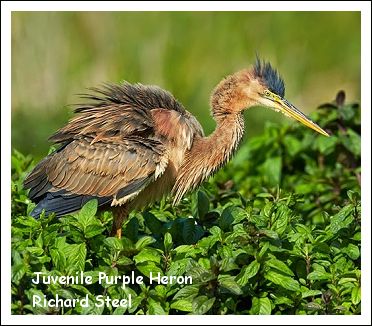 Steve's texts alerted us to the fact that John Dawson had discovered a Purple Heron on the reserve during the morning, I assume this was during the monthly wildfowl count that took place on Sunday when a group of volunteer wardens do a complete circuit of the mere, flushing the birds out of cover so that observers in the observatory can count them. Steve's texts alerted us to the fact that John Dawson had discovered a Purple Heron on the reserve during the morning, I assume this was during the monthly wildfowl count that took place on Sunday when a group of volunteer wardens do a complete circuit of the mere, flushing the birds out of cover so that observers in the observatory can count them.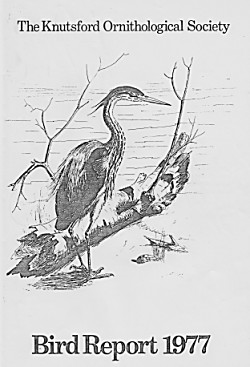 I arrived in the obs. about 1:30pm, joining a couple of the regulars who'd seen the bird a few minutes previously, it had unfortunately moved out of view but they had the appropriate spot in view through their high-end 'scopes. After a short wait the bird re-appeared and showed well for a couple of minutes - it was a juvenile, an overall brown colour with a bright yellow bill and legs. My old 'scope struggled as the bird was right at the far end of the mere, a distance of about a kilometer, but through those more modern instruments it showed quite well. I arrived in the obs. about 1:30pm, joining a couple of the regulars who'd seen the bird a few minutes previously, it had unfortunately moved out of view but they had the appropriate spot in view through their high-end 'scopes. After a short wait the bird re-appeared and showed well for a couple of minutes - it was a juvenile, an overall brown colour with a bright yellow bill and legs. My old 'scope struggled as the bird was right at the far end of the mere, a distance of about a kilometer, but through those more modern instruments it showed quite well.Other visitors came and went but we didn't see the Heron again and, as far as I know it was never re-located. The last Rostherne record was probably the bird seen 40 years ago on 11th July 1977 by Ron Harrison and Tom and Gisele Wall, it featured on the cover of our KOS annual Bird Report of that year - a lovely drawing by the late Russell Fox. Wednesday (26th) was a bit of a disaster, it was raining heavily as we arrived at the Woolston Eyes reserve and this continued for most of the morning. As we walked over the bridge onto the reserve a couple of birders were on their way out and told us that they'd had Common Sandpiper, Little Ringed Plover and two Wood Sandpipers earlier in the morning in front of the Morgan hide. The Wood Sandpipers would have been a new species for two of our number but unfortunately, anticipating there would be no more visitors during the morning due to the inclement weather, the wardens had decided to do some strimming in that area and as a consequence the birds of interest had left. Still at least it was dry in the hide and we were able to enjoy our sausage rolls in comfort! Don't forget, on Friday evening (28th) we will be enjoying our third and final Friday evening walk of the Summer, this time around the eastern side of the Northwich Woodlands area taking in Neumann's Flash, Haydn's Pool and the high ground of Carey Park across the Carden's ferry bridge.Clicking on the image of the 1977 bird report will download a copy of the whole report or click here to open the same publication in the form of a "flip book". The report was written in longhand, typed out by Elizabeth Perkins and printed by her husband, KOS Secretary, Peter who fortuitously worked for Rank Xerox! A long overdue visit on a fine sunny morning (22°C) to Burton on Wednesday (12th), looking back in my notes our last trip to the Wirral was back in March of this year so we had plenty of catching up to do. The highlights of the breeding season on the reserve were summarised on a whiteboard in the reception building - 30 Avocet chicks, 80+ Little Egret nests, a pair of Mediterranean Gulls + 2 chicks and a pair of Cattle Egrets 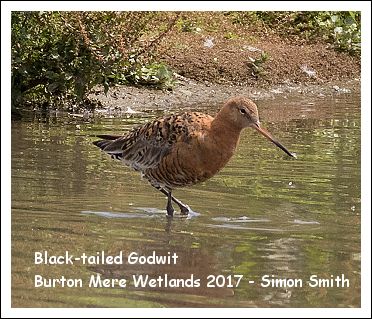 whose single offspring had recently fledged - the northward march of Mediterranean species continues apace, perhaps to escape the heat down there where the temperature passed 47°C in Spain during last week! whose single offspring had recently fledged - the northward march of Mediterranean species continues apace, perhaps to escape the heat down there where the temperature passed 47°C in Spain during last week!Great White Egrets and Spoonbills had been recorded recently on the reserve; no sign of those but there was plenty of other activity on the pools in front of the centre with c 23 Dunlin, 3 Ruff, Black-tailed Godwit and Mediterranean Gull plus Shelduck, Little Egret, Avocet, Lapwing and Black-headed Gulls all with young at various stages in their development. 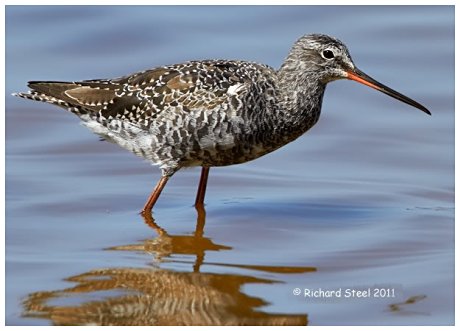 Common Whitethroat, Chiffchaff, Reed Warbler and Sedge Warbler were all still in song as we made our way around to the marsh covert hide pausing briefly at the spot where the nest of the Cattle Egrets could be seen, the birds weren't there but judging from the well trampled ground the viewing point had seen lots of activity over the previous weeks. Great views from the marsh covert hide through the hastily set up 'scopes of four Spotted Redshanks, three still in breeding plumage - beautiful birds. Further round at the inner marsh hide a count of three with two in Summer plumage, perhaps part of the same group as they were quite mobile. Also from inner marsh large numbers of Icelandic (Islandica)Black-tailed Godwits in all manner of plumages could be seen; some still in Summer attire, others already in their grey and white Winter colours - as the species doesn't breed until two years old these could have been non-breeders that summer south of their breeding areas, juveniles have their heads and breasts tinged cinnamon-buff. It's all very complicated and I had to resort to volume 3 of BWP which confused me even more - still the nine volumes in their spectacular dust wrappers look pretty impressive on the bookshelf! Interestingly a few pairs still nest in East Anglia and in attempt to increase numbers a technique known as "headstarting" is being employed. The same methods, under much more challenging conditions, are being used to help the Spoon-billed Sandpipers in the high Russian arctic.
A welcome break in the run of cold weather on Saturday (1/7) for our KOS trip over to Lake Vyrnwy, a light drizzle as we left Knutsford but dry, sunny and warm as we arrived at our destination. It's a fair old drive so we started off in the 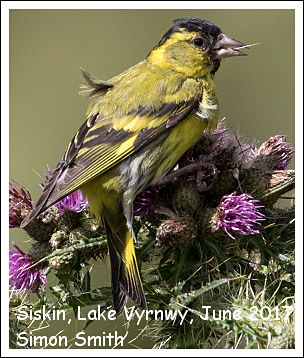 artisans coffee shop, conveniently located close to the RSPB information centre, before moving across the car park to the RSPB hide. The feeders were proving very popular with Blue, Great and Coal Tits plus the usual exceptional views of Siskins just inches away through the glass screen. artisans coffee shop, conveniently located close to the RSPB information centre, before moving across the car park to the RSPB hide. The feeders were proving very popular with Blue, Great and Coal Tits plus the usual exceptional views of Siskins just inches away through the glass screen.From the hide we began the long uphill walk along the minor road that forms part of a number of circular trails crisscrossing the area. I'm pleased to report that all members of the party made it to the top - no mean feat for some; it's very steep in places! Despite the late date there was still a certain amount of song with Chiffchaffs, Blackcaps and Garden Warblers heard, as usual there was some confusion with the two sylvia warblers, although Bob Groom never seems to have any problem differentiating between the two! Just one sighting of Pied Flycatcher and, disappointingly, no Spotted Flycatchers this year. We spent some time resting at the top of the hill with it's panoramic views of the valley to the south-east and the reservoir and dam in the other direction, conditions were ideal for soaring raptors but we had only Buzzards, nice enough of course but there are nesting Hobbies in the area and a quick view of them would have been appreciated. Having descended the hill we had lunch back at the cars before walking up to the dam where Swallows and House Martins were feeding and a pair of Grey Wagtails showed well on the outlet. Across at the RSPB centre we found our visit had coincided with an optical demonstration day; a whole range of mainly RSPB and Viking badged binoculars to appraise plus some Swarovskis, way ahead of the rest in quality (and price!) although at least one member did spend a lot of time looking through the latter and seemed quite tempted - I satisfied myself with a cup of RSPB coffee - excellent value at only
£
1.20 - proper stuff from one of those machines that automatically slices the top off a capsule before squeezing it into the cup, not like the instant gunge at Burton Mere! Back in Mobberley, along Pavement Lane, on Thursday afternoon (29th) I was lucky enough to have a calling Greenshank flying over and a family of Lesser Whitethroats in the thick hedge of the Cherrydale highland cattle fold. It was here many years ago that Stuart Burnet ringed a family of five birds one of which was recovered in Israel, confirming that the species migrates around the eastern Mediterranean rather than across it further west. Bob tells me that despite five visits to the location, he and Jacquie have seen a Hobby only once this year at what had become a traditional nest site on the outskirts of Knutsford so it appears that one of the pair didn't make it back this year and the survivor has moved on. We were saddened last week to hear of the death of Jim Middleton after a long illness, he was the husband of Susan one of the society's joint lectures officers. Jim's funeral will take place on Friday this week and I know a number of KOS members will be attending. Our thoughts are with Susan and her family at this most difficult of times.
The picture from the last update (20/6) taken on our Scotland trip - KOS complete with thick coats, hats and gloves illustrates the prevailing conditions for most of the week we were there - cool but relatively dry. What a change when we returned to Cheshire, from Friday (16th) through to Wednesday (21st) we had to endure the hottest June 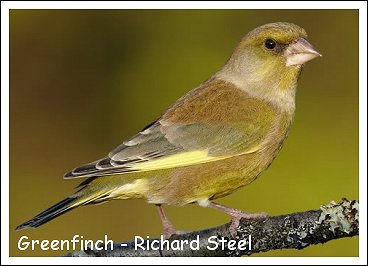 weather since the heat wave of 1976 with the temperature peaking at 30
°C
on the 18th. weather since the heat wave of 1976 with the temperature peaking at 30
°C
on the 18th.Fortunately things had returned to normal by Friday evening (23rd) for the second of our Summer walks, this time around the Northwich woodlands led on this occasion by Jacquie Ledward. There was an excellent turnout with a total of 17 members and friends plus two very well behaved pooches. Unfortunately Bob Groom was late arriving and the rest of us had set off before he arrived at the meeting point, he guessed we'd be making for Haydn's pool via Witton Brook so took that route - alas he'd guessed wrongly but had some good records as he ploughed his lonely furrow in the direction of Haydn's. Amongst our number we were pleased to welcome Malcolm and Shona who'd joined us for the evening and hope, in the course of time, to learn a little more about their garden birds, especially their songs and calls; of course this is not a good time of the year for song but a few species obliged as we made our way along. One of the first birds on the evenings list was a Peregrine perched in the distance on one of the remaining chimneys at the old ICI Winnington works, from there Jacquie led us through some parts of the area we'd not explored before, starting with Hopyards Wood, over Marbury Brook, up to Marbury Lane (we knew this bit) and from there across the fields to Cogshall Lane and eventually back to the cars, a distance of about three kilometers. Blackbirds were still in full song, as was a Song Thrush which was putting on a virtuoso performance just before we entered Hopyards wood, perhaps a final flourish before going silent until around mid-December when they'll resume for a short time prior to another period of silence until they really go for it in the Spring!. A Greenfinch wasn't singing but it's characteristic "wheezing" call betrayed its position on an overhead wire as we approached, it remained there allowing us good views. The wood was very quiet but the familiar song of a Chiffchaff gave our guests a "new one" although I think they had heard one previously but not recognised the species involve. An onomatopoeia apparently and word of the day from Darren the Ranger!! Crossing the fields towards Cogshall Lane we heard a Common Whitethroat and two Yellowhammers but all were a distance away and difficult to pick out, the Yellowhammers may continue to sing for some time, I've heard them as late as September in the past. Over at Haydn's and along the riverside Bob added Goldcrest, Oystercatcher, Swift and singing Willow Warbler, Reed Warbler and Blackcap to the evenings species list. Two reminders - this coming Saturday (1st July) we travel to Lake Vyrnwy for our July field trip, leaving Lilac Avenue at 08:30am. Based on previous years I'm presuming on arrival we'll start in the cafe before visiting the hide adjacent to the car park where we can expect to see Pied Flycatcher, Siskin and, if we're lucky Marsh Tit. Climbing up the hill we may bump into more Pied Flycatchers, Spotted Flycatcher, Tree Pipit, Wood Warbler and there's a possibility of some raptors - perhaps Red Kite and Hobby. On the 25th May there was even a Crag Martin over the lake, only the 10th British record - you never know - but no guarantees of course!! A little further ahead, from September 28th to October 1st we'll be visiting the north-east staying for 3 nights at Ashington Premier Inn stopping off at RSPB Saltholm on the way up. Seahouses, Bamburgh, Budle Bay and Lindifarne on the Friday, a full day on Lindisfarne on the Saturday, returning on Sunday via somewhere like Fairburn Ings or Leighton Moss depending on the route chosen. Contact me or Derek if you have any questions about either trip.
The Rostherne Cuckoo remained on the reserve until at least last Wednesday (31st) when Bob Groom had good views of the bird as it flew directly overhead. Bob and Jacquie report seeing two male Yellow Wagtails at the Sudlow Lane site yesterday and later at another location saw a Hobby at last years nest site (plus good supporting cast of singing Yellowhammer, 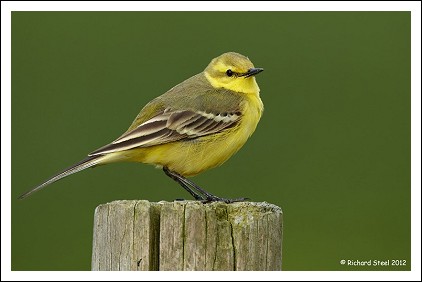 Whitethroat, Blackcap, Great Spotted Woodpecker etc.). I took a walk around the Fox Harbour area of Mobberley where we've enjoyed some KOS evening walks in previous years, four singing Yellowhammers and the same number of Skylarks but again no Sand Martins this year at the sand quarry on "Simcock's big hill" Whitethroat, Blackcap, Great Spotted Woodpecker etc.). I took a walk around the Fox Harbour area of Mobberley where we've enjoyed some KOS evening walks in previous years, four singing Yellowhammers and the same number of Skylarks but again no Sand Martins this year at the sand quarry on "Simcock's big hill"The number of young birds out and about is increasing, Geoff and Sheila have been visited by their first juvenile Great Spotted Woodpecker of the season and in Mobberley we have been inundated with young Goldfinches who are consuming vast quantities of sunflower hearts; they're vanishing at an alarming rate - don't they realise how much that stuff costs! Derek Pike was the first person to mention the appearance of this years young Starlings - a small group on the field at the rear of Lilac Avenue; this is a species that seems to have really hit the skids in the very recent past, only a few years ago, when the birds were feeding young, steady streams of parent birds carrying food were to be seen passing over the lane up to Gleavehouse Farm commuting between the Town Lane area and Fox Harbour - this year hardly any were to be seen. Wednesday (7th) sees us off on a KOS jolly to Speyside, I have set a target of 100 species for the week long trip but with a poor long range weather forecast that may be a little optimistic. Some of our more adventurous members are already planning to hike up to the top of Cairngorm at 1,245 meters in search of Dotterel and Ptarmigan etc. - I'll be waiting in the cafe at the top of the funicular railway for the re-appearance of any survivors! The mini-heat wave peaked on Friday (26th) with a temperature in Mobberley of 28 °C recorded during the afternoon. It was the day of our KOS evening walk in the Pennines based in and around the Goyt Valley. There was little in the way of song mainly Willow Warblers, 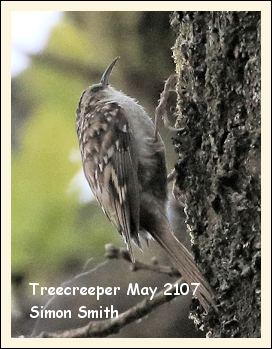 Robins and Blackcaps, not unexpected given the late hour (7:30pm). There was no sign of any flycatchers but we did see a nice male Redstart, a Treecreeper showed well enough for Simon to grab a record shot and we had what we hoped would be the first of many views of Woodcock as one shot passed us at a rate of knots, vanishing quickly into the gloom of a conifer plantation. We walked as far as the seating area next to the River Goyt before returning to the cars along the valley road as the light began to fail. Robins and Blackcaps, not unexpected given the late hour (7:30pm). There was no sign of any flycatchers but we did see a nice male Redstart, a Treecreeper showed well enough for Simon to grab a record shot and we had what we hoped would be the first of many views of Woodcock as one shot passed us at a rate of knots, vanishing quickly into the gloom of a conifer plantation. We walked as far as the seating area next to the River Goyt before returning to the cars along the valley road as the light began to fail.We drove out of the valley to a second location where, for the past two years, we'd been lucky with Nightjars and roding Woodcocks; it was now becoming quite chilly and a strong breeze had members reaching for their fleeces! Geoff and Sheila saw a Woodcock on the drive to second location but the rest of us didn't see a single one during the hour or so we spent there. As a bonus, as we were preparing to leave, the ISS (International Space Station) passed overhead - 200 miles up and 17,000mph - fascinating and a first for those members of the society who missed it passing over Llandudno on one of our trips in 2015 - preferring instead the delights of a Premier Inn treacle pudding!! During the early part of the evening Jean Emsley took a different route to other members of the party and was lucky enough to hear a Cuckoo calling on a number of occasions. Nearer to home, at Rostherne, Steve Collins also had a Cuckoo and got close enough to the bird to get the record shot shown above - thanks Steve.
The warmest day of the year so far with the temperature peaking at 24.7 °C for our second walk this season around the perimeter of runway 2 at Manchester airport. 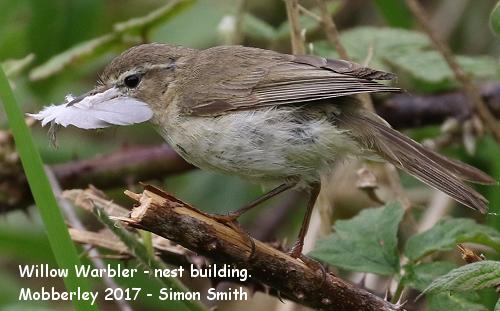 The amount of song has declined slightly as the breeding season progresses but all the usual species were heard - Chiffchaff, Willow Warbler, Blackcap, Garden Warbler, Common Whitethroat and three singing Lesser Whitethroats. At one point a Phylloscopus warbler carrying a small white feather appeared a few yards in front of us perching briefly on a barbed wire fence before dropping into a tangle of brambles from where it re-appeared a few seconds later minus the feather. Careful examination revealed it's nest, a small domed affair made from dry grasses hidden deep in the undergrowth. Moving on a short distance and the bird returned with another feather; quite unconcerned by our presence - Simon fired off some shots which showed it to be a Willow Warbler - great stuff! Driving home from his monthly wildfowl count duties at Tabley Bob Groom came across a Yellow Wagtail along Sudlow Lane in Knutsford ........Driving back after the Tabley count I saw a male on the road, just where Derek and I have seen one in previous years, near the sharp bend on Sudlow Lane. Several vehicles came up and it flew off but I parked by the gateway and had very nice views of it foraging along the track until it flew into the middle of the rape field (which, incidentally, has a lot of beehives in it). Hopefully it was going to a nest . Definitely worth keeping an eye on.... Tomorrow evening (Friday 26th) we have our first KOS evening walk of the Summer, this year to the Goyt Valley and beyond, meeting up at the Tatton Street car park at 6:30pm or the second car park along the valley at 7:30pm - "roding" Woodcock guaranteed and perhaps other species of more than passing interest!
The dry spell of the last few weeks seems to have ended with a steady drizzle for most of yesterday continuing into this morning (16th). Fortunately the rain held off on Saturday (13th) for our KOS May field trip to the Manifold Valley, although it didn't look too promising as we made our way over the Pennines with strong winds and fog as we approached the Cat & Fiddle. 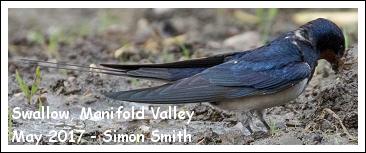 It was here that we had a pleasant surprise to start the day as, through the mist, a large bird could be seen hanging in the air supported on the strong updraught, at first we thought it was a Buzzard but as we drove closer we could see it was a Red Kite - in Cheshire too a good record for the 2017 bird report as it's still seldom seen in the county. It was here that we had a pleasant surprise to start the day as, through the mist, a large bird could be seen hanging in the air supported on the strong updraught, at first we thought it was a Buzzard but as we drove closer we could see it was a Red Kite - in Cheshire too a good record for the 2017 bird report as it's still seldom seen in the county.A group of 14 gathered for the start of the walk at Ecton, this year, for logistical reasons, we set off along part of the Manifold Way in a clockwise direction, along the east side of the river. The expected species were all present Redstart, Chiffchaff, 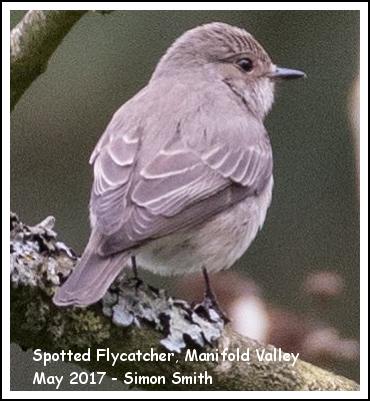 Willow Warbler, Blackcap and Garden Warblers were all in full song at this time of the year revealing their presence as we moved through the valley. Goldcrests were very vocal as we continued, joined at one point by a well-hidden Treecreeper with it's understated offering causing some discussion. Approaching Dale Farm we added House Martin and Swallow to the day-list, the Swallows landed just a few yards from where we were watching as they collected nest building mud from the farmyard. Willow Warbler, Blackcap and Garden Warblers were all in full song at this time of the year revealing their presence as we moved through the valley. Goldcrests were very vocal as we continued, joined at one point by a well-hidden Treecreeper with it's understated offering causing some discussion. Approaching Dale Farm we added House Martin and Swallow to the day-list, the Swallows landed just a few yards from where we were watching as they collected nest building mud from the farmyard. By now the weather had brightened up and we were able to enjoy a late morning break in the sunshine sat outside the excellent Wetton Mill Tearoom half way round our route. A Dipper showed well for us just across the other side of the river but there was no sign of the Spotted Flycatchers that were nesting at this spot when we last visited the area a couple of years ago. Setting off for the second half of the route we walked along the west side of the river, eventually passing through the Swainsley tunnel and then back to the cars. We heard (and watched) more singing Blackcaps plus the only Common Whitethroat of the day and about halfway back Simon picked out a female Goosander sat in a well-hidden spot by the side of the river. It appeared to have adopted a pose that would normally be associated with a bird that was incubating eggs, we watched for some time but it didn't move - the problem is of course Goosanders nest in holes in trees or artificial nest boxes - not out in the open, so the jury's out on that one. Finally, just past the exit from the tunnel, we met up with a very obliging Spotted Flycatcher that performed well over the stream just below where we stood watching. 45 species this year, no Cuckoo this time but perhaps we'll have more luck with them on the 26th when we return to the Goyt Valley and surrounding area for the first of our Friday evening outings - they have been heard there this Spring.
A couple of nice records this morning on a pleasant walk around the lanes of Mobberley with singing Yellowhammer and Lesser Whitethroat (one of each) heard in the big field opposite Smith Lane Farm, a second 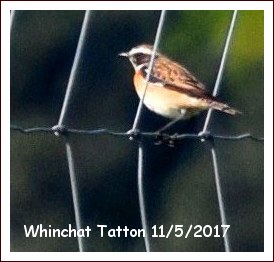 Lesser Whitethroat and a Common Whitethroat were in song on Mobberley SQ (now known officially as the community meadow) where the work done over the Winter months seems to have been a success as the water level doesn't appeared to have dropped much recently despite the run of dry weather we've experienced. The area has also attracted an Oystercatcher on more than one occasion (perhaps breeding locally) and a passing Arctic Tern seen by local resident Judith Swan. Lesser Whitethroat and a Common Whitethroat were in song on Mobberley SQ (now known officially as the community meadow) where the work done over the Winter months seems to have been a success as the water level doesn't appeared to have dropped much recently despite the run of dry weather we've experienced. The area has also attracted an Oystercatcher on more than one occasion (perhaps breeding locally) and a passing Arctic Tern seen by local resident Judith Swan.Late news from Rostherne where Bob Groom tells me the logbook reveals that an Osprey passed through on the 30th April with three Black Terns on the same day. Alan Booth had a Black Tern over Tatton Mere last Thursday (4th) whilst, more recently in the park, Darren Morris had a Whinchat yesterday and this morning (11th) a Common Sandpiper and, surprisingly, a very late Fieldfare! As tradition demands Swifts have arrived back in Knutsford town centre in time for the May Day celebrations - Jude Halman had her first over St. John's Avenue on Saturday morning (6th) and Derek Pike reports three over Lilac Avenue the following morning. 20 ° C on Wednesday (10th) when we drove over to the Woolston Eyes reserve for a gentle mornings birding. Plenty of warblers in song with good numbers of Chiffchaff, Common Whitethroat, Reed Warbler, Sedge Warbler and Blackcap heard but only a couple of Willow Warblers and neither sight nor sound of Cetti's Warbler or the Lesser Whitethroat reported earlier in the week. There are now three broods of Black-necked Grebes on number 3 bed, these are apparently very early and if the weather holds there is the possibility of second broods coming along later in the season. This Saturday we have our May field trip to the Manifold Valley, an excellent area and were going at the optimum time of the year - this is definitely not one to miss!
A beautiful Wednesday morning (3rd) for our first visit of the season to the Goyt Valley up in the Pennines, wall-to-wall blue sky but a strong, cool wind from the east made it feel quite chilly. 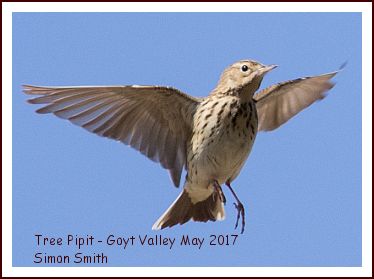 Target species at this location were Tree Pipit, Spotted Flycatcher, Pied Flycatcher, Wood Warbler and Redstart; the Manchester Bird Forum has reported all but the Wood Warblers this Spring already so we were cautiously optimistic when we met up at the middle car park on the shore of the Errwood Reservoir where we were joined by ex-KOS members Mark Eddows and Alison Lea who'd driven over from Bonsall for a mornings birding. Target species at this location were Tree Pipit, Spotted Flycatcher, Pied Flycatcher, Wood Warbler and Redstart; the Manchester Bird Forum has reported all but the Wood Warblers this Spring already so we were cautiously optimistic when we met up at the middle car park on the shore of the Errwood Reservoir where we were joined by ex-KOS members Mark Eddows and Alison Lea who'd driven over from Bonsall for a mornings birding.Our route took us up the steep slope at the rear of the car park before turning to walk along the path above and parallel to the valley road which we eventually joined and walked along as far as the challenging stone steps down to the River Goyt. Elevenses were enjoyed out of the wind by the riverside before we climbed up the gentle path back to the road and eventually back to the cars. If you've ever wondered where all our Willow Warblers have gone to I can reveal they're safe and well and can be found here in the Goyt Valley - lots of them! As the population has declined in our part of the world it's increased further north where it's a little cooler, Mark theorised that in the Goyt, at 1000ft asl - even in the valley, it's cooler than on the Cheshire Plain and they will still thrive until climate change decrees otherwise. No signs of any Flycatchers or the Wood Warblers but we did hear singing Redstarts at two locations and the Tree Pipits performed brilliantly for us climbing high into the air before parachuting down, legs dangling, back to the tree tops. Simon's picture shows this well, plus all the salient identification features associated with this species. Hugh Pulsford was ringing on Knutsford Moor whilst we were up in the hills, he reports that a Black Tern passed over during the morning and the news that the Cetti's Warbler he controlled there last September had been ringed earlier in South Yorkshire at an RSPB reserve near Barnsley. Barbara and Alan Langston kindly sent me a picture taken in their Mobberley garden of a remarkable young Robin. As you can see from the picture it's wholly white and as far as I can see a pure albino bird. Colour aberrations are very common in birds but a full albino is not and unfortunately they don't last long in the wild because their eyesight is badly affected by the condition. It's all very complicated but if you want to make your own mind up about this bird click here and prepare to be confused!
Bob Groom reports "end-to-end" Sand Martins at Tatton on Tuesday (25th), 500+ with some overflowing onto Melchett Mere, also a few House Martins and Swallows plus the first two Swifts of the year. Later in the day he was with Elaine and his grandchildren over at Rostherne to view the Cormorant colony (now 132 nests apparently!) and estimated the same number of Sand Martins there. Proceedings were interrupted by the storm that hit the area in mid-afternoon - hail, snow, thunder and lightening! I was safely ensconced at home where my weather station recorded a drop of 6.3 ° C down to 4 ° C in as many minutes - makes a change from the heat and dust of Morocco Bob! 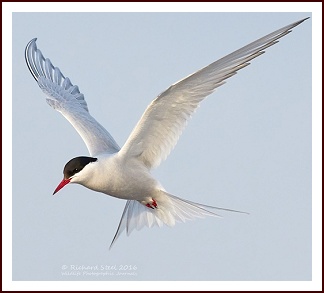 The following day (26th) I did a walk from Knutsford Moor, through Dog Wood as far as the old bathing area and back, a Reed Warbler was singing in the Moor reed bed, a lone Willow Warbler (becoming something of a rarity nowadays) was heard from the Higmere plantation where I counted seven Heron's nests four of which were active and contained well-grown young. All three hirundine species were present over Tatton Mere in small numbers and c. 15 Swifts flew high over Dog Wood. A male and female Mandarin rested on the concrete jetty that juts out into the mere just beyond Dog Wood, the birds nest in natural holes in any convenient tree and recently one was perched incongruously in an oak tree overhanging Mobberley brook, just off Smith Lane close to where I'd seen them previously. The following day (26th) I did a walk from Knutsford Moor, through Dog Wood as far as the old bathing area and back, a Reed Warbler was singing in the Moor reed bed, a lone Willow Warbler (becoming something of a rarity nowadays) was heard from the Higmere plantation where I counted seven Heron's nests four of which were active and contained well-grown young. All three hirundine species were present over Tatton Mere in small numbers and c. 15 Swifts flew high over Dog Wood. A male and female Mandarin rested on the concrete jetty that juts out into the mere just beyond Dog Wood, the birds nest in natural holes in any convenient tree and recently one was perched incongruously in an oak tree overhanging Mobberley brook, just off Smith Lane close to where I'd seen them previously.It was Tatton again for me yesterday (1st) - the May Bank Holiday and a very pleasant day, cloudy at first but becoming pleasantly warm as the sun appeared later in the day despite quite a strong breeze from the east. It was this wind that was responsible for bringing an unusual number of Arctic and Black Terns to the UK, there were numerous sightings and I was hopeful that Tatton would have it's share. Initially I saw only Lesser Black-backed Gulls passing through but eventually an Arctic Tern joined them; just the one but a satisfactory end to the afternoon! Bob was over at Woolston on Friday (25th) with a friend and had Reed and Sedge Warblers plus an increasingly rare Cuckoo. Apparently Black-necked Grebes are down in number this year on the Reserve with only 13 birds present, but there's still time for others to arrive. Friday's AGM went well and was done and dusted in 10 minutes after which Sheila whetted our appetites for next month with her excellent presentation entitled "Scottish Wildlife" visiting some of the places we'll be seeing again in a few weeks time. Incidentally it'll be interesting to see at first-hand the reaction of the locals to the result of the big event that takes place whilst we're up there [click here]!  23/04/2017......A great day out at Brockholes
We've endured some pretty bleak conditions during our birding activities over the past few months, so I'm sure nobody would begrudge us the warm, benign Spring weather we enjoyed yesterday (22nd) on our April field trip to the Lancashire Wildlife Trusts Brockholes Reserve 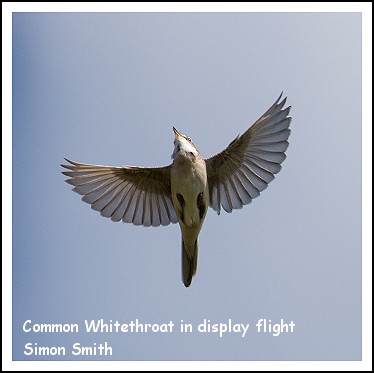 just off junction 31 of the M6 motorway, about 45 minutes from Knutsford. just off junction 31 of the M6 motorway, about 45 minutes from Knutsford.14 members made the journey north and were capably managed by the day's trip leader Jude Halman who'd obviously done this sort of thing before with the Knutsford and Vale Royal Ramblers and wasn't about to put up with any nonsense from the usual suspects! Further round the path, where it runs alongside the M6, traffic noise became a problem and identification of the birds from their song became more challenging, so it came as a relief as we entered the relative peace and quiet of Boilton Wood, at this time of the year carpeted with bluebells and home to Nuthatches and Blue, Great and Coal Tits but surprisingly no Willow warblers - in fact we didn't see or hear one all day. Don't forget our AGM this coming Friday (28th). This never takes long, 15 mins. maximum, after which our Chairman Sheila will be giving a presentation entitled "Scottish Wildlife" - very appropriate with our holiday there coming up in early June.
KOS members Bob Groom, Simon Smith and Lyn Graves have now returned from their adventures in Morocco and judging by Bob's report and Simon's excellent pictures they seem to have thoroughly enjoyed themselves. You can read the report by clicking here. Barry Jordan, currently in Cyprus on anti-poaching duties has kindly sent me some sightings from the island - At Agia Napa Football Fields though there were at least twenty one Lesser Grey Shrikes and just a few female Red-backed Shrikes this morning. Six Pallid Swift and a few Red Rumped Swallows were flying over and there were also a couple of Whinchat. The water has nearly all gone from Oroklini Marsh but there were also over twenty Spur-winged Lapwing on the mud together with several Common Ringed Plover, a Little Ringed Plover and some Little Stint. On the fields next to the Larnaca Desalination Plant there was a flock of at least two hundred Yellow Wagtail feeding together with a Whinchat and an Isabelline Wheatear. A common Cuckoo was seen in the area too along with a Red Footed Falcon. A bit different from Knutsford Moor!! Keep up the good work and send us some of those Wagtails Barry! Our Waxwings appear to have moved on, Steve Collins had a flock at St. Vincent's School on Monday (17th) but I've not seen them on Town Lane for a couple of days now. Still it was good while it lasted and we enjoyed our 15 minutes of fame; I talked to a number of visitors and made sure they left with one of our KOS business cards, so we may see one or two new faces at future KOS meetings. Someone asked what was going on in a Facebook group, a link to this site produced a spike in visitor numbers and some additions to the emailing list. Some late news from Tatton where Derek Pike saw Coot and Mallard youngsters on a pool in the gardens this afternoon and Darren the Ranger reports that the Egyptian Geese have bred successfully on a pool in front of the mansion. Don't forget our April field trip on Saturday (22nd) to Brockholes (Arctic Terns almost guaranteed!) Leaving Lilac Avenue at 08:30am. 14/04/2017...... Waxwings return to Mobberley
On Sunday (9th) Alan Booth had an early Common Sandpiper on the concrete jetty in Tatton park; also there a Kingfisher and two Mandarins. Last week I flushed a male and a female Mandarin from Mobberley Brook where it runs alongside Slade Lane, they have nested in the village in the past. Thanks Mark (we have a KOS trip to the Manifold Valley on 13th May when we'll be meeting up with Mark and Alison. This is one of the outings on our 2017/18 programme which will be issued at the AGM on the 28th.) Lyn, Simon and Bob have returned safely from their birding adventures in Morocco. I saw Bob this morning at the Waxwing site and he tells be it was an amazing trip with every bird he'd hoped for seen well plus some "lifers" as a bonus. Apparently Simon has some excellent images so hopefully I'll receive some of these in due course to include in Bob's trip report that he's already started writing! 13/04/2017...... The first airport walk of the year.We've enjoyed some unseasonably warm weather since the last update; last Saturday (8th.) my weather station recorded a range of no less than 19 ° C between the day's maximum and minimum temperatures (1C and 20C), on Sunday it was even warmer peaking at 21 ° C. Since then though things have returned to normal for the time of year and this morning (12th) on our first walk of the year around runway 2 at Manchester airport the temperature never rose above 10 ° C. Chiffchaffs, 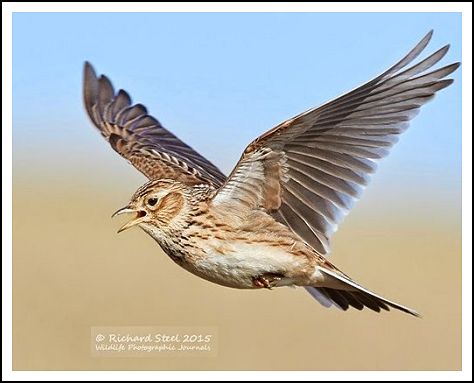 Blackcaps and Willow Warblers were present in good numbers, especially the first two species but, apart from a single House Martin struggling against a strong westerly wind, these were the only Summer migrants we recorded, it was disappointing not to have any Common Whitethroats yet but it's still early, last year we had to wait until the 22nd for our first. The three warblers showed well for us, as did a singing Goldcrest - Britain's smallest bird competing with the noise of the worlds biggest passenger aircraft, an Emirates A380, on runway 2 clawing its way into the skies on it's way to Dubai, home of the world's tallest building the Burj Khalifa ( did you know it's not connected to a sewerage system, they use trucks to take the sewage out of individual buildings and then they wait on a queue to put it into a waste water treatment plant!). Skylarks are also not phased by the noise, they nest in good numbers on the grass alongside the runways at the airport and could be heard in song throughout the morning. Blackcaps and Willow Warblers were present in good numbers, especially the first two species but, apart from a single House Martin struggling against a strong westerly wind, these were the only Summer migrants we recorded, it was disappointing not to have any Common Whitethroats yet but it's still early, last year we had to wait until the 22nd for our first. The three warblers showed well for us, as did a singing Goldcrest - Britain's smallest bird competing with the noise of the worlds biggest passenger aircraft, an Emirates A380, on runway 2 clawing its way into the skies on it's way to Dubai, home of the world's tallest building the Burj Khalifa ( did you know it's not connected to a sewerage system, they use trucks to take the sewage out of individual buildings and then they wait on a queue to put it into a waste water treatment plant!). Skylarks are also not phased by the noise, they nest in good numbers on the grass alongside the runways at the airport and could be heard in song throughout the morning.New KOS member Bernard Clenaghan reports a Chiffchaff on Knutsford Heath last Wednesday (5th) and the following day he had a second bird on his first ever visit to the Moore Nature Reserve. You may also enjoy the Woolston Eyes Reserve too Bernard, it's also in Warrington and a couple of hours there can be very rewarding. Which reminds me that permits for Woolston run from April to April so I assume that any KOS members who frequent the Reserve have renewed theirs! Society members are off on their travels once again and I know that currently three are in Morocco, one in Western Canada and a third risking life and limb helping other volunteers in Cyprus on anti-poacher patrols! Our next KOS field trip is to the excellent Brockholes Nature Reserve just off junction 31 of the M6, taking place a week on Saturday (22nd) meeting in Lilac Avenue at 8:30am.
Things happen quickly at this time of the year as Spring moves on apace, blink and you miss it! No sooner I had uploaded the latest update on Friday (31st) than an email arrive minutes later from Steve Scrimgeour who reported a flock of House Martins over Knutsford Moor, this is the same date as our first record last year when we had a single bird flying over Tatton Mere. The following day (1/4) Bob Groom and Jacquie Ledward visited Budworth Mere and reported c.500 Sand Martins, 15 Swallows and a single House Martin. As well as the now established Chiffchaffs and Blackcaps they also had two newly arrived Willow Warblers. Derek Pike reports two Swallows arriving back at their nesting site in Peover on Monday (3rd) - the same date as last year, one flew over Mobberley SQ on the same afternoon whilst a short time later I was delighted to see a Red Kite circling over Bucklow Avenue, just up the road from the SQ, this could well be the same wild bird that Bob has seen recently on a couple of occasions on his local patch. On a rather chilly Wednesday morning (5th) we met up for a walk around the Northwich Woodlands area and hadn't left the Witton Bridge car park before hearing the softly descending song of a Willow Warbler, the first of the year for most of us. Ospreys have arrived back early this year and the staff at the Montgomeryshire Wildlife Trust's Dyfi Reserve have been busy over the Winter preparing again to stream HD video of the proceedings - click here.
Wednesday morning (29th) found us on a gentle stroll around Tatton, beginning as usual at the Dog Lodge lay by, across Knutsford Moor to the park's main entrance, along the side of Tatton mere to the Allen hide before returning to the cars via Dog Wood. As well as the now well established Chiffchaffs a Blackcap was singing on the Moor, this was not the first of the season though as Barry Jordan had one on the 23rd at the same location. From the hide we saw a few Sand Martins passing through and enjoyed good views of a Kingfisher perched in front of us, Jude Halman had seen one here a few days ago so they may be nesting in the banking on the edge of Melchett Mere, one of the few possible nesting sites in the Park. On the way to Dog Wood Jude noticed some birds high up in the tree tops, just before the concrete jetty, they weren't easy to see being silhouetted against the sky but they were calling and proved to be Bramblings. This is a favourite spot for them at this time of the year and some will remain with us until the end of April. Bob Groom has seen a Red Kite again over Moss Wood "thermalling" with a number of Common Buzzards, he considered this a wild bird despite the proximity of the Gauntlet bird of prey centre. He also reports counting four Ravens over Knutsford Moor last Saturday (25th), I saw two this morning (31st) on a pleasant walk in the warm Spring sunshine around the fields to the south of Mobberley SQ. There were no Wheatears yet in the horse paddocks but, along the road towards Gleavehouse farm, Tree Sparrows were very active and a Linnet was singing at the top of a roadside oak tree. The large field just behind the SQ was used for barley last year and hasn't been touched since harvest time, it was attracting Meadow Pipits, a nice pair of Yellowhammers and a flock of no less than 60 Linnets! Two Skylarks were in song but I hope they don't try to nest there as, over at the far side, the farmer was dumping another load of manure in advance of ploughing etc preparing the land for this years crop.
We had a long wait this year for our first Sand Martin but eventually one appeared over Tatton Mere at 2:45pm yesterday afternoon (22nd) and half an hour later a group of 11 passed through, they didn't linger long but flew off heading steadily north. So Sue Heath wins this year's Sand Martin competition with her guesstimate of 10:00am on 21st March and will receive a copy of the very collectable 1989 Breeding Bird Atlas of Cheshire and Wirral. 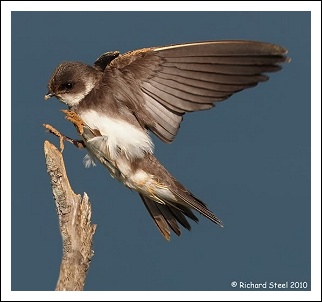 Thanks to all who have spent so much time in the wind and rain over the past couple of weeks looking for the first Martin - Darren Morris, Roger Barnes, Bob Groom, Jean Brookes and our Hon.secretary Derek Pike. It would be nice if this level of activity in the park were to continue for the next couple of months - Cetti's warblers could well attempt to nest on the Moor before too long and the improvements made in Dog Wood will make that area more attractive to Flycatchers, especially as appropriate nest boxes have been provided. Groups of up to a dozen Goldeneye can still be seen on the main mere, Chiffchaffs are increasing by the day, a Kingfisher has been seen most days along the banking between the concrete jetty and the old bathing area and a large black and white Buzzard sized bird has been seen by the garden staff on two consecutive days hovering over a large pond containing Koi carp, unfortunately they're not birders and two blurred pictures have proved inconclusive, but it could be an Osprey! Thanks to all who have spent so much time in the wind and rain over the past couple of weeks looking for the first Martin - Darren Morris, Roger Barnes, Bob Groom, Jean Brookes and our Hon.secretary Derek Pike. It would be nice if this level of activity in the park were to continue for the next couple of months - Cetti's warblers could well attempt to nest on the Moor before too long and the improvements made in Dog Wood will make that area more attractive to Flycatchers, especially as appropriate nest boxes have been provided. Groups of up to a dozen Goldeneye can still be seen on the main mere, Chiffchaffs are increasing by the day, a Kingfisher has been seen most days along the banking between the concrete jetty and the old bathing area and a large black and white Buzzard sized bird has been seen by the garden staff on two consecutive days hovering over a large pond containing Koi carp, unfortunately they're not birders and two blurred pictures have proved inconclusive, but it could be an Osprey!We spent yesterday morning (22nd) at a very cold and wet Woolston Eyes reserve - three or four Chiffchaffs were in song but no other warblers yet, it'll be great to hear the Common Whitethroats again, there were loads here last year. Black-necked Grebes are back, we counted five birds one of which was a youngster from last year just starting to moult into adult plumage. Canada and Greylag geese were paired up, there was much activity amongst the resident Shovelers and squabbling Black-headed Gulls added to the general atmosphere of anticipation we see each Spring amongst our birds (and birdwatchers!)
Sunday (12th) found us on the Wirral Peninsula for our KOS March field trip, Parkgate to begin with followed by the RSPB's Burton Mere Wetlands reserve. The tide was quite high - 9.4M at 10:30am but it soon became apparent that wouldn't be enough to force the sea up anywhere near the quayside where we waited. Nevertheless we had some good birds including close views of female Marsh and Hen Harriers with more distant views of a Great White Egret out on the estuary it's yellow bill plain to see through "Oscar" Derek's Swarovski 'scope that I'd borrowed for the day! Rather than hang about until noon for the Parkgate Chippy to open we decided to travel to Burton via Little Neston, close to the Harp Inn at the end of Marshlands Road, where a group of fellow birders from Southport suggested we'd have a good chance of catching up with the Water Pipits that have been wintering in the area. No luck unfortunately as this is a good time to catch them in early Spring plumage, so we carried on to Burton where the excellent butties from Chris's catering van provided more than adequate compensation for having had to miss the chippy (bacon and egg barm £ 3 - hot drinks are still available from the Reception building). A Wheatear and a single Sand Martin had passed through earlier, their first records of the year, 63 Avocets were counted on the Reserve, coming close to outnumbering the Lapwings. Having plenty of time we walked as far as the Inner Marsh hide via the Marsh Covert hide where a Little Egret was feeding, just in front of where we were sat. It was fascinating to watch it agitating the water and mud to disturb any prey and then snapping up those that appeared close to the surface. New KOS member James captured this in the short video shown below. Later on when most of us had left for home he had two Cattle Egrets from the Reception building - species 62 for the day.
The first Sand Martins of the year have arrived in the UK with one as far north as Crosby on Merseyside on Monday (6th), despite a number of members spending time in Tatton every day this week there's been no sign of them so far. It won't be long though, the temperature is rising as an area of warm air moves up from Iberia and this should bring more birds over the coming weekend. While we wait for the first of the Summer 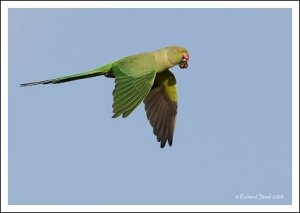 migrants to return there's plenty of other activity; Bob Groom had 50 Siskins in the alder trees at the north end of Tatton Mere on Saturday (4th), Geoff and Sheila counted four on the 8th whilst Steve Collins reports some excellent sightings in his part of Knutsford .......like everybody else it seems from your report I waited longer than usual for Siskin and Lesser Redpoll, here Goldfinch dominated the feeders but this week I have had up to 6 Brambling, 6+ Siskin, 6+ Lesser Redpoll and 4 Reed Bunting on the feeders in the garden. Occasional Bullfinch and even a Goldcrest so things looking good in the garden now! Sheila tells me there their Bramblings have moved on, perhaps only as far as Tatton where Steve Scrimgeover, enjoying a relaxing lunchtime walk along Beech Walk in the park, had a flock of 20 to 30 - thanks for the report Steve. migrants to return there's plenty of other activity; Bob Groom had 50 Siskins in the alder trees at the north end of Tatton Mere on Saturday (4th), Geoff and Sheila counted four on the 8th whilst Steve Collins reports some excellent sightings in his part of Knutsford .......like everybody else it seems from your report I waited longer than usual for Siskin and Lesser Redpoll, here Goldfinch dominated the feeders but this week I have had up to 6 Brambling, 6+ Siskin, 6+ Lesser Redpoll and 4 Reed Bunting on the feeders in the garden. Occasional Bullfinch and even a Goldcrest so things looking good in the garden now! Sheila tells me there their Bramblings have moved on, perhaps only as far as Tatton where Steve Scrimgeover, enjoying a relaxing lunchtime walk along Beech Walk in the park, had a flock of 20 to 30 - thanks for the report Steve.Sighting of the week though must be the two Ring-necked parakeets on the feeders at the home of Jayne and Nick Davies along Bernisdale Road in Mobberley. Nick's seen them in Manchester but never in Mobberley before, I can't recall seeing this species in the wild anywhere - mind you I rarely have reason to travel south of Stoke and I know they've become a pest in certain parts of the south of England. On Tuesday I walked from the Dog Lodge car park to Tatton's old bathing area to look for Sand Martins via Knutsford Moor, considering the time of year I managed a respectable list of 43 species including Oystercatcher, Pintail and 4 Mandarin Ducks (1M+3f). The Grey Herons are nesting in Higmere Plantation and I counted at least five active nests - there are probably more. Roger Barnes tells me that over at Budworth Mere a pair of Little Egrets have joined the nesting Herons this year. Roger has, in the past, found the first Sand Martin of the year during early morning walks through Tatton on more than one occasion, including one on the 8th March - Tatton's earliest ever record. A man for records is Roger - newer members may not be familiar with his real claim to fame! click here to be impressed!
Local birders have seen few Siskins and Redpolls this Winter, Geoff and Sheila Blamire have hosted a few Siskins and just a single Redpoll recently in their garden at Mere. Here in Mobberley we've not had either species so far in our garden and further up Bucklow Avenue Len Mason reports that numbers in his also are well down compared with previous years. 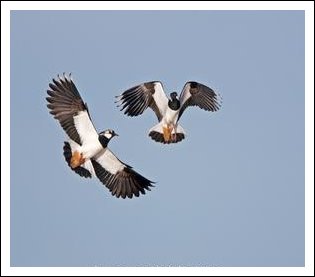 Perhaps there's plenty of food out in the countryside, along Mobberley brook this morning a flock of around 50 Siskins were noisily feeding in the waterside alders; they normally appear in greater numbers at the beginning of March prior to heading north for the breeding season. Redwings and Fieldfares are also flocking, Bob Groom had c.300 Fieldfares and c.150 Redwings along Green lane in Knutsford last Saturday (25th), they should be with us for a few more weeks though, we normally see both species until the first week in April. There was some snow on Tuesday morning (28th) but it didn't last long and quickly melted away after a few hours. Later that morning, high over the big fields opposite Smith Lane farm in Mobberley, the first Skylark of the Spring poured out it's song - a tiny speck visible only with the binoculars. This morning (2nd) at the same location we welcomed back the first displaying Lapwings of the year - a truly evocative sound - Winter's almost over! Perhaps there's plenty of food out in the countryside, along Mobberley brook this morning a flock of around 50 Siskins were noisily feeding in the waterside alders; they normally appear in greater numbers at the beginning of March prior to heading north for the breeding season. Redwings and Fieldfares are also flocking, Bob Groom had c.300 Fieldfares and c.150 Redwings along Green lane in Knutsford last Saturday (25th), they should be with us for a few more weeks though, we normally see both species until the first week in April. There was some snow on Tuesday morning (28th) but it didn't last long and quickly melted away after a few hours. Later that morning, high over the big fields opposite Smith Lane farm in Mobberley, the first Skylark of the Spring poured out it's song - a tiny speck visible only with the binoculars. This morning (2nd) at the same location we welcomed back the first displaying Lapwings of the year - a truly evocative sound - Winter's almost over!As far as the Met. Office is concerned Spring begins on the 1st. March so we're there already, but of course, as I've said before, the KOS Spring begins with the first Sand Martin over Tatton Mere. We've had 24 entries for this year's Sand Martin competition, as I didn't advertise it externally most entries are from KOS members but ex-member Malcolm (Monty) Greenhalgh and our friend from Iceland Edward Rickson have joined in. Dates range from an optimistic March 3rd through to a pessimistic 21st! Click here for a full list. Although the return of the first of the Martins remains uncertain we can be sure that next Thursday (9th) the Hon. Sec. and Mrs. Brookes will be returning from their Winter quarters and once more his dulcet tones will be heard echoing around Cheshire's favourite birding spots! If I don't do an update until then Derek has asked me to remind everyone that we have our March Field trip to Parkgate and Burton Mere on Sunday 12th, leaving from the Tatton Street car park at 8:30am. This promises to be a good day with a high tide and the promise of Sand Martins and perhaps Wheatears at Burton Mere. Tonight (3rd) it's the AGM of the Cheshire and Wirral Ornithological Society. 7:45 at the Catholic Church on Tatton Street in Knutsford. After the formalities of the AGM David Quinn the artist will be giving a presentation entitled "Seeing birds in a magical new light" - From the first pencil strokes of a field sketch, through to the final touches of a major painting, the Artist and Illustrator offers an insight into the challenges of capturing the essence of birds, whether portrayed in their natural setting, or on the stark white page of a Field Guide. David will talk about how he forms and develops ideas for his paintings, explaining some of the processes involved in observing, researching and depicting his subjects in a variety of drawing and painting media. He emphasises a deep appreciation for the great privileges of seeing birds, and for life as an Artist who studies them. Some of his new original paintings and drawings will be on display to augment the slide show presentation. 23/02/2017...... Plenty to see at Burton MereBob Groom and Jacquie Ledward drove over to the RSPB reserve at Burton Mere last Saturday (18th) and judging from Bob's email enjoyed some excellent birding - ............"After a damp start the day quickly improved. En route we saw 2 Kestrels and 2 Buzzards. At Burton Mere, the first 2 Avocets had returned, there were 10 Whooper Swans, 3 Marsh Harriers were almost constantly in the air, spooking 1,000 plus Lapwings over and over again, I also glimpsed a Merlin that had been logged earlier. There were good numbers of Black-Tailed Godwits, Redshanks and at least 9 Dunlins. c.100 Golden Plovers went up near the IMF hide. Many hundreds of Pink-Footed Geese, also Canadas, Greylags and 7 species of duck. 4 Buzzards were up together. ( We returned later in the day and had several views of the Cetti's Warbler 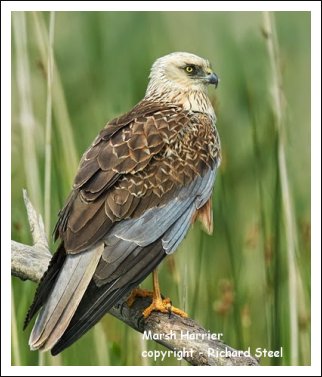 but didn't manage to see the reported lesser spotted.) There were lots of Little Egrets at Denhall Lane and a pair of Stonechats. Parkgate produced the bird we had hoped for, a ring-tail Hen Harrier that gave close views, as did a hunting Peregrine. There were many Curlews, a couple of Oystercatchers and more Little Egrets. An unusual sighting was 4 male Stonechats perching up together, but no short-eared owl, unfortunately........" but didn't manage to see the reported lesser spotted.) There were lots of Little Egrets at Denhall Lane and a pair of Stonechats. Parkgate produced the bird we had hoped for, a ring-tail Hen Harrier that gave close views, as did a hunting Peregrine. There were many Curlews, a couple of Oystercatchers and more Little Egrets. An unusual sighting was 4 male Stonechats perching up together, but no short-eared owl, unfortunately........"We followed in their footsteps yesterday morning(22nd) and did very well racking up a substantial total of 60 species. Avocet numbers had increased to seven and the large flock of Lapwings were kept on the move by the presence of three Marsh Harriers. The Avocets and Lapwings enjoyed a very successful breeding season last year due to the installation of an anti-predator fence, one of the wardens told me that this will be used again this year. The pools in front of the Inner Marsh hide were relatively quiet but three Whooper Swans showed well and in amongst the Black-headed gulls was one individual with a very noticeable pink wash on it's breast. In all other respects it was just a Black-headed Gull but it's appearance did give rise to a certain amount of speculation! In Tatton and on Melchett Mere Bob noted plenty of action when he visited on the 16th. ".....Melchett Mere area was particularly lively, the highlights being 15 Snipe flying into the marsh and 3 Pintails (2 m, 1 fem) on the mere, along with 8 Cormorants, a Heron, 50+ Mallards, 6 Tufted Ducks, a female Goldeneye, a Little Grebe and 3 Great Crested Grebes (a pair were head-shaking and weed carrying), Moorhens and Coot. A Buzzard perched, later 3 were circling, a hovering Kestrel and a circling female Sparrowhawk. Also Great Spotted Woodpecker and a Jay..." Tomorrow evening (Friday 24th) we have our February indoor meeting when Mike Roberts will be giving us a presentation entitled "Bittern Diaries" - 7:45pm in the Jubilee Hall. Finally don't forget to enter the World famous "Sand Martin Competition" closing date - next Wednesday (1st. March)
Some years ago we used to run an annual competition where visitors to this website were challenged to predict the time and date that the first Sand Martin of the year would be seen in Tatton Park,  normally over Tatton's main mere, Melchett mere or Knutsford Moor. KOS members would spend some time each day scanning the three areas as did our friends the Tatton Rangers - not a foolproof method but good enough for our purposes. After some encouragement I've decided to re-introduce the competition. normally over Tatton's main mere, Melchett mere or Knutsford Moor. KOS members would spend some time each day scanning the three areas as did our friends the Tatton Rangers - not a foolproof method but good enough for our purposes. After some encouragement I've decided to re-introduce the competition.So you simply Click on this link to enter (sorry now closed for this year) you will be asked to enter your name, location, email address and your estimate of the appropriate time and date (it'll only take a minute). You may want to know that the earliest date recorded is 8th March: the latest is 22nd March and the average is 14th. Your email address will only be used if you win and I need your postal address so that you can be sent the prize! The competition is open to anyone who passes this way and not just for society members, it will run until March 1st, after which I will put a list of entrants on the website.I'm not sure this will all work but I'm cautiously optimistic - so please give it a go and - good luck!! 13/02/2017...... KOS trip to Pennington FlashA maximum temperature of only 4 °C backed up by a strong easterly wind for our trip over to Wigan's Pennington Flash on Sunday (12th) and, despite some Probably due to the park having a such a well populated catchment area, even on such a cold day, the paths were very busy with walkers, runners and mountain bikers enjoying the morning - no conflicts of interest though, there was room for all and I noticed that some of the bikes even had bells! Not many passerines about in the undergrowth alongside the paths but there was more to see on the water, as well as the usual Coots, Moorhens, Tufted Ducks and Mallards there seemed to be plenty of Goldeneye, I later found out that 46 were present during an earlier count. As we watched from the first hide along the route (East Bay Hide) our attention was drawn to a small duck making it's way quickly over the flash, it proved quite elusive spending much of it's time under water but eventually we got reasonable views and were able to identify it as the first Winter male Long-tailed Duck that has spent some weeks at Pennington. Ramsdale's Flash is a continuation of the main flash and here we found the majority of the wildfowl, away from the sailing dinghies and out of the wind - Teal, Great Created and Little Grebes, five Scaup and no less than 40 Goosanders - immaculate plumage, handsome birds in the bright, late Derek and Jean seem to have settled into their accommodation in Portugal and Derek reports seeing Swallow, Bluethroat and Flamingo already from their bedroom window ....... Weather better today about 16c we have been sat on balcony watching tide roll in....... I received a nice email from Hazel Raw over the weekend.........I had a wonderful experience on Thursday this week. I drove into Tatton Park and went to sit on the bench opposite Melchett Mere. It was around 11.45. Around noon I noticed two Water Rails in the undergrowth to the left of where I was sitting. On a branch of a tree adjacent to where they were a Kingfisher was standing, at the end of the branch, and it proceeded to dive down and fly back to the branch with a fish in its bill. The Water Rails became agitated and a Heron flew over. The Water Rails disappeared into the undergrowth. ........ Great stuff Hazel and a reminder that it's often just as productive to sit and wait for the birds to come to you rather than charge around looking for them! The cold spell is coming to an end, apparently by Thursday we'll be enjoying temperatures up in the mid-teens and the BBC will be able to return to worrying about the NHS and what will happen when Donald gets bored with early morning tweets and tries to find out what that big red button's for.
A large high pressure weather system over continental Europe is forecast to expand over the next few days, eventually covering the British Isles bringing much colder weather including some snow. So you've been warned  - although Daily Mail and Express readers will no doubt already know about this and begun stocking up on essential supplies or finalised plans to flee to the Iberian Peninsula for a month! - although Daily Mail and Express readers will no doubt already know about this and begun stocking up on essential supplies or finalised plans to flee to the Iberian Peninsula for a month!Before then though we've been enjoying some pleasant days - cold but dry and a number of our resident species were in song this morning in Mobberley - Blue, Great and Coal Tits, Robin, Dunnock, Song Thrush, Mistle Thrush, Goldcrest and, five days earlier than last year, the first Chaffinch spluttered into song along Smith Lane. No sign yet of Lapwings and Skylarks on the big fields opposite Smith Lane Farm - perhaps they know it's better to wait just a little longer. Last Wednesday (1st) we spent the morning at Woolston Eyes, 39 species, nothing out of the ordinary, although from the bridge we watched a male Kingfisher as it hunted below us, it remained for some minutes, giving time for Derek to get it in the 'scope and allow everyone excellent close-up views - a second bird appeared briefly before flying off towards the weir.
A busy weekend for KOS members began on Friday evening (27th) with a well-attended presentation by the much travelled wildlife photographer / filmmaker Mike Leach entitled "Owls of the World".  Mike's an excellent speaker articulate, witty and authoritative; I'm sure we'll be welcoming him back before too long. Mike's an excellent speaker articulate, witty and authoritative; I'm sure we'll be welcoming him back before too long.Two new members have helped to swell our ranks recently so a warm KOS welcome to Bill Boyle from Knutsford and James Devaney from Lymm. The following morning (28th) we joined our chums from Friends of the Moor for an hours birding on the Moor as part of the RSPB's Big Garden Birdwatch. The weather wasn't too promising - steady rain to begin with but by the end of the period things had improved as the two groups we'd formed met up again the collate the results. 31 species this time, four down on last year but not too surprising given the conditions. Once again we were fortunate enough to hear a Water Rail calling from the reedbed, 14 Shovelers on the moor pool were a surprise and good numbers of Redwings were present this time - due perhaps to the extremely cold weather they're currently enduring on continental Europe. On Sunday (29th) it was the turn of the Heath as we got together with the Friends of the Heath for a similar exercise, although it covers about the same area as the Moor there's not the variety of habitats we enjoyed yesterday and we only managed 17 different species. Having said that those species that were present were well represented with good numbers of Blackbirds, Blue and Great tits and Robins in abundance! Bob Groom and Jacquie Ledward enjoyed a good day at the coast on the 28th - We stayed at BMW until the weather picked up, which fortunately it did. The tally included at least 4 Marsh harriers, close views of a ringtail Hen Harrier, 2 Peregrines, 2 Kestrels and 2 Buzzards (but no short-eared owl) plus excellent views of a Great White Egret, 2 Stonechats, massive number of Lapwings and the usual waders, ducks and geese. The only downside was the damp cold that chilled to the bone.. Closer to home and KOS members Steve Collins and Phil Dell were in the Whitley hide at Rostherne and it appears that they were lucky enough to be in the right place at the right time! A Bittern made a flight appearance today at Rostherne-The first this winter I think. Phil and I were in the Whitley Hide about 12.30 and were talking about the Bitterns last year when one obligingly flew from left to right from the reeds near the channel across in front of the hide on a beautiful day! Unfortunately I hadn't got my camera out and was gutted but delighted to see it! I remember last year that when they flew they often came back shortly after so decided to stay for my lunch for an hour. It nearly caught me out as I was scoping around but at 1.15 it came back and flew across right to left to where it originally came from and landed in the reeds in the channel area. I always wanted a reasonable flight shot of a Bittern and nearly missed it and only got one photo in focus, but as they say, you only need one! Terry and Sue Heath currently have Bramblings visiting their Knutsford garden, they seem to be widespread this Winter, Derek and Jean had 12+ along Beech Walk in Tatton whilst Geoff and Sheila have two in their garden on a regular basis, as well as a male and female Siskin. CAWOS (Cheshire and Wirral Ornithological Society) have their latest meeting this Friday (3rd February) with a presentation by Mike Lane entitled "A Digital Lane" Mike is a full-time wildlife photographer specialising in birds and mammals, which he has done for more than 40 years. He gets to travel widely and has been to over 50 countries, but his main love remains photographing British wildlife which is more challenging. He believes that there is a technique or location where nearly all British birds can be photographed relatively easily if you know how. A Digital Lane tells of various places around the globe, starting with Black Grouse in Scotland, Finland for Brown Bears, diving Ospreys and then to some amazing drinking pools for birds in Hungary. Sounds good - 7:45pm at the Catholic Church on Tatton Street.
A cold but relatively dry day on Sunday (22nd) for our annual Wildfowl Watch in conjunction with the Tatton rangers,  held at the Allen hide on the edge of Melchett mere. The temperature was 1.5
°
C at 11:00am and had only struggled up to 2
°
C by the time we shut up shop at 1pm but the park was quite busy with groups of walkers enjoying an invigorating walk before lunch despite a few intermittent light snow showers earlier in the morning. held at the Allen hide on the edge of Melchett mere. The temperature was 1.5
°
C at 11:00am and had only struggled up to 2
°
C by the time we shut up shop at 1pm but the park was quite busy with groups of walkers enjoying an invigorating walk before lunch despite a few intermittent light snow showers earlier in the morning.Days like this can be very enjoyable as long as appropriate clothing is worn, yes of course we all look forward to Spring and the return of the warmer weather and our Summer migrants, but it's no use wishing the Winter away - it won't happen any quicker and time passes quickly enough as it is, especially when you've passed your sell-by date - carpe diem! A good turnout of KOS members with 10 in attendance ready to deal with the great British public, as usual I positioned myself on the roadside close to the entrance, posh new KOS business cards in hand and attempted to persuade passers-by that their visitor experience would be enhanced by spending a few minutes in the Allen hide. The task was made so much easier this year as Yvonne and Darren Morris had set up a refreshment Visibility wasn't too good, with a light mist hanging over the mere but a few ducks and geese were on offer and the feeders were pretty busy all morning and I didn't hear any complaints as people left! Thanks to all the KOS members who attended - especially Yvonne and Darren the Ranger for arranging the refreshments. Mobberley Sand Quarry (SQ) as we call it lies just off the B5085 at the edge of the village; it's the wet part of what's known as the Community Meadow and was purchased by the village a few years ago to stop it falling into the hands of any developers, including the ever expanding Manchester Airport. A busy weekend ahead for members starting on Friday evening with our first indoor get together of the year - Mike Leach will be giving a presentation entitled "Owls of the World". On Saturday morning we'll be taking part in the Big Garden Birdwatch on Knutsford Moor with the Friends of the Moor, followed on Sunday by a similar event on Knutsford Heath in conjunction with the Friends of the Heath. Both events begin at 11:00am and will last for the one hour allowed - any members who'd like to attend would be most welcome. Send me an email if you require further details of any of these events - tony@10X50.com
A good start to the New Year with 62 species seen between the two sites we visited on our first field trip of 2017 (14th January), beginning at Warrington and the Moore Nature Reserve in the morning before driving over to Marbury Country Park at lunch time.  The weather wasn't too promising on our arrival at Moore it was raining quite heavily and the temperature was only 4 ° C (in fact it never rose over 6 ° C all day). In the trees above the car park and the first entries on the day list, a number of Lesser Redpolls, not good views as they were watched only in silhouette high up in the tree tops. The first of the hides is along Lapwing Lane overlooking Lapwing Pool and from there we had nice views of a good selection of wildfowl including Wigeon, Goldeneye, Mallard, Pochard, Teal, Coot, Moorhen and a very obliging Little Grebe feeding just a few yards in front of us, it's path underwater revealed by a tell-tale stream of bubbles and moving vegetation. The feeding station was well stocked and attracting a steady stream of visitors - Reed Buntings, Blue, Great and Coal Tits but no sign, on this occasion, of the Willow Tits that are one of the Reserve's main attractions; they're a rapidly declining species and may have vanished altogether from Moore, this may also be the case with Lesser Spotted Woodpecker, another Reserve speciality conspicuous by it's absence.  Birchwood Pool held a few gulls - Black-headed, Lesser Black-backed and Common, Bob found us his usual Sparrowhawk which gave good views through the 'scope when it landed opposite us in a birch tree - as we watched a Green Woodpecker appeared briefly flying towards the feeding station, species 44 for the morning. It didn't feel any warmer over at Marbury as we sat in the viewing screen overlooking Budworth mere and the Coward reedbed, a Bittern had been seen here earlier in the week, no sign of it on this occasion but we did see a Kingfisher and heard at least two Water Rails calling from the reeds. On the mere good numbers of Great Crested Grebes (c60 were counted recently) plus Greylags and Shoveler for the day's final tally of 62 species. There are still plenty of Waxwings around the area but they have yet to re-discover the berry laden cotoneaster trees in Mobberley that kept them sustained for some weeks during the last irruption a couple of years ago. Bob Groom with Darren and Yvonne Morris caught up with the birds at Tesco Northwich on the 30th December, but only very briefly before they quickly vanished - never to be seen again. Jayne and Nick Davies were pleased to have a Brambling visiting their garden in Mobberley on the 10th whilst over in Mere Geoff and Sheila Blamire currently have three Bramblings - they've now been around for a couple of weeks. The latest KOS committee meeting took place on Friday evening at Geoff and Sheila's home. Treasurer Frank Dearden was happy with the financial situation and he'd allocated Sue and Jacquie a little more money this time for speakers and they've booked some really good ones for the next season (2017/2018).
|
||||||||||||||||||||||||||||||||||||||||||||||

 but the surrounding woodland was more interesting as a large mixed flock of passerines moved through - Blue, Great and Long-tailed Tits plus a few Goldcrests, overhead two Ravens, Blackbirds, Redwings and a single Song Thrush.
but the surrounding woodland was more interesting as a large mixed flock of passerines moved through - Blue, Great and Long-tailed Tits plus a few Goldcrests, overhead two Ravens, Blackbirds, Redwings and a single Song Thrush. measured on my weather station reached 55mph at 7pm (it's mounted only about 15' above the ground and surrounded by trees) but earlier in the day Ophelia brought us some unseasonably warm temperatures, just short of 20
°
C during the afternoon as I sat in the garden watching the comings and goings on the bird feeders. We just put out sunflower hearts, the Goldfinches love them and we see them throughout the year, recently we've welcomed back Blue, Great and Coal Tits, a Nuthatch and the first Greenfinches of the season.
measured on my weather station reached 55mph at 7pm (it's mounted only about 15' above the ground and surrounded by trees) but earlier in the day Ophelia brought us some unseasonably warm temperatures, just short of 20
°
C during the afternoon as I sat in the garden watching the comings and goings on the bird feeders. We just put out sunflower hearts, the Goldfinches love them and we see them throughout the year, recently we've welcomed back Blue, Great and Coal Tits, a Nuthatch and the first Greenfinches of the season.






 it's characteristic yellow orbital ring showing well; the Hon. Treasurer further identified it as a male bird after close examination through his pre-Galilean instrument! Later in the day we were quite excited when a lone Whimbrel flew over us but apparently they're common on the reserve and at this time of the year a flock of 150 roost on the island each evening prior to moving north later in the Spring: they don't nest in England.
it's characteristic yellow orbital ring showing well; the Hon. Treasurer further identified it as a male bird after close examination through his pre-Galilean instrument! Later in the day we were quite excited when a lone Whimbrel flew over us but apparently they're common on the reserve and at this time of the year a flock of 150 roost on the island each evening prior to moving north later in the Spring: they don't nest in England.

 A second bird was singing from close by when we returned some time later but these were the only two we came across during the morning. Haydn's Pool was quiet, the water level was very low and not looking very attractive for any Oystercatchers or Little Ringed Plovers that have nested there in the past; nevertheless there was plenty of mud and two Green Sandpipers were obviously finding it to their liking, but of course they won't be breeding in Cheshire, before too long they'll be off north and east to Scandinavia or northern Russia, although a few pairs are reported to have nested in Scotland in the past. A large flock of hirundines were in flight over Budworth Mere, possibly around 500, predominately Sand Martins with a few Swallows and just one House Martin. There's a plume of warm air moving up from the south over the next few days so that will bring with it more migrants, our friends at the well-watched Woolston Reserve have already welcomed back the first Grasshopper Warblers and Common Whitethroats of the season.
A second bird was singing from close by when we returned some time later but these were the only two we came across during the morning. Haydn's Pool was quiet, the water level was very low and not looking very attractive for any Oystercatchers or Little Ringed Plovers that have nested there in the past; nevertheless there was plenty of mud and two Green Sandpipers were obviously finding it to their liking, but of course they won't be breeding in Cheshire, before too long they'll be off north and east to Scandinavia or northern Russia, although a few pairs are reported to have nested in Scotland in the past. A large flock of hirundines were in flight over Budworth Mere, possibly around 500, predominately Sand Martins with a few Swallows and just one House Martin. There's a plume of warm air moving up from the south over the next few days so that will bring with it more migrants, our friends at the well-watched Woolston Reserve have already welcomed back the first Grasshopper Warblers and Common Whitethroats of the season. As a bonus, as the morning ended, news came through of three Waxwings just across the road along Garden Road, Terry Heath and Bob Groom sprinted off in that direction and were lucky enough to connect with the three before they flew off into the nearby estate (the birds that is, not Bob and Terry).
As a bonus, as the morning ended, news came through of three Waxwings just across the road along Garden Road, Terry Heath and Bob Groom sprinted off in that direction and were lucky enough to connect with the three before they flew off into the nearby estate (the birds that is, not Bob and Terry). was the home of Redshanks and Little Ringed Plovers and an excellent spot for passage migrants in the Spring and Autumn. Greenshank, Spotted Redshank, Whimbrel, Ruff, Little Stint, Turnstone we had them all over the years! Unfortunately the lake became smaller and smaller until it started to dry up completely during the Summer months. Recently though an effort has been made to reverse this trend and an excavator has been used to dredge and deepen it, the excess mud and soil has been used to form two islands so it should be an interesting place to watch once again this coming Spring.
was the home of Redshanks and Little Ringed Plovers and an excellent spot for passage migrants in the Spring and Autumn. Greenshank, Spotted Redshank, Whimbrel, Ruff, Little Stint, Turnstone we had them all over the years! Unfortunately the lake became smaller and smaller until it started to dry up completely during the Summer months. Recently though an effort has been made to reverse this trend and an excavator has been used to dredge and deepen it, the excess mud and soil has been used to form two islands so it should be an interesting place to watch once again this coming Spring.